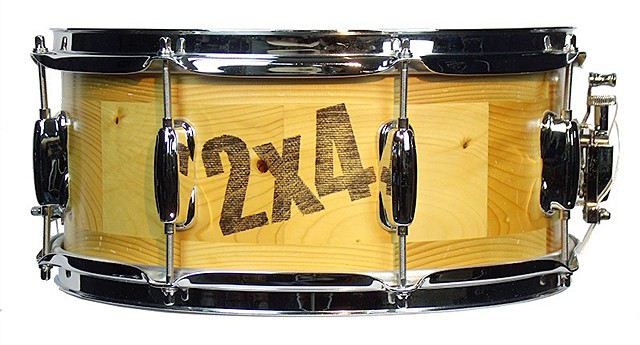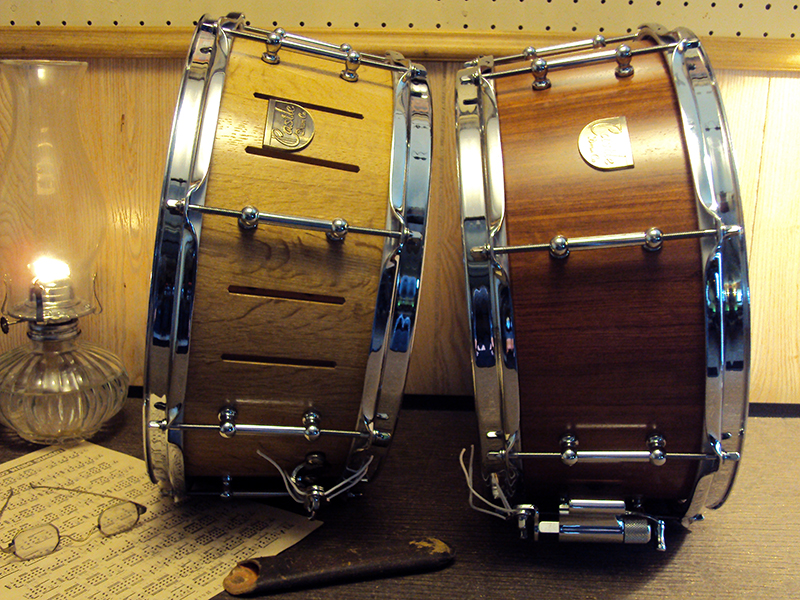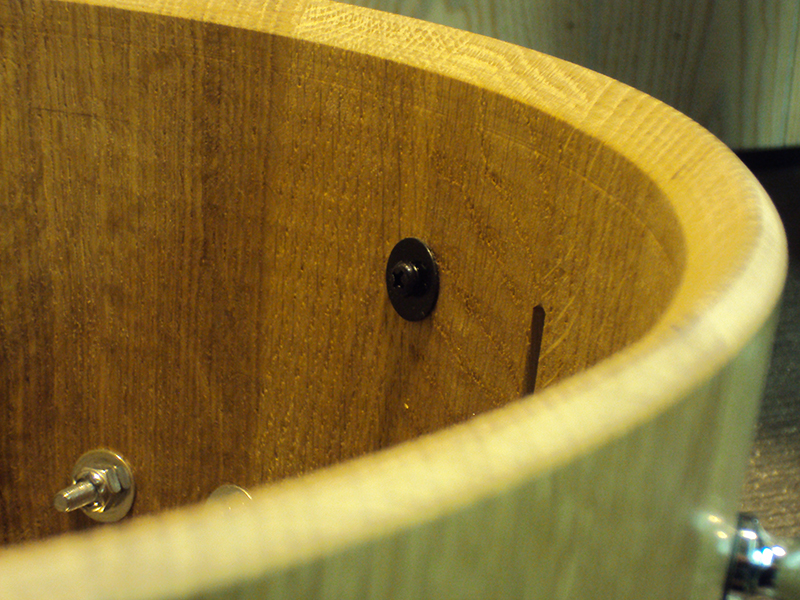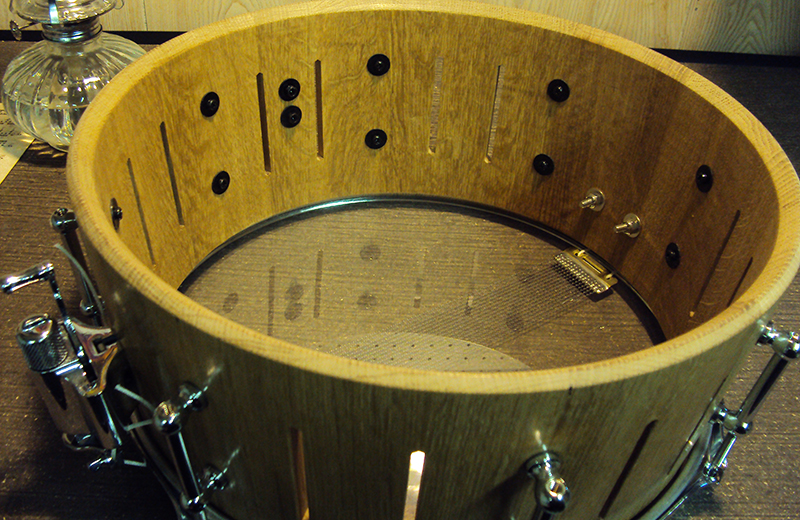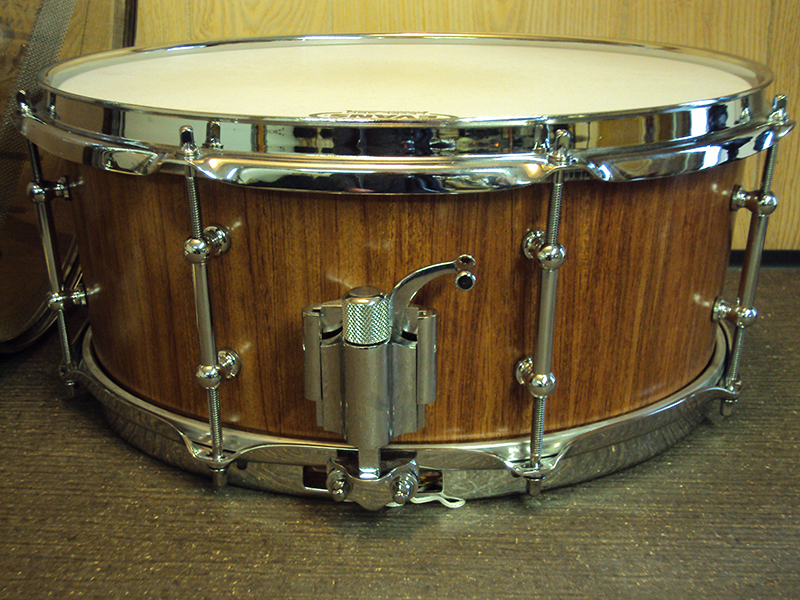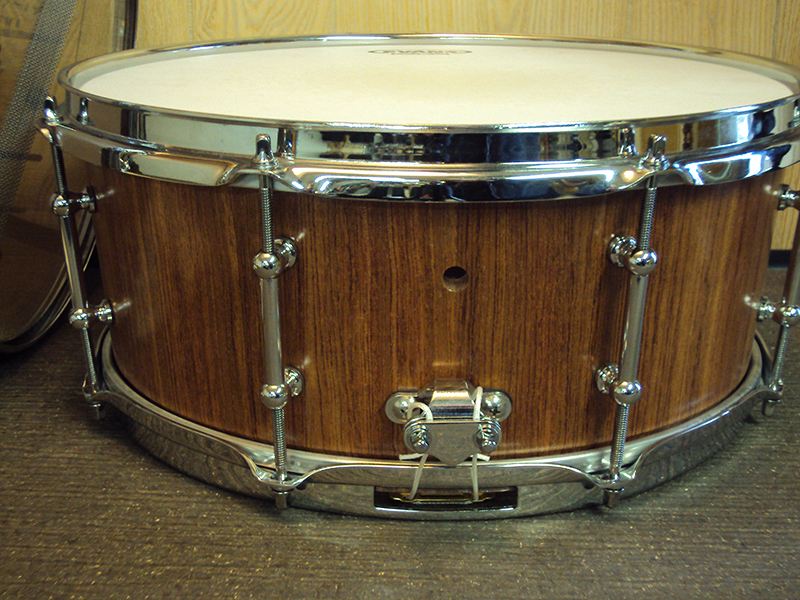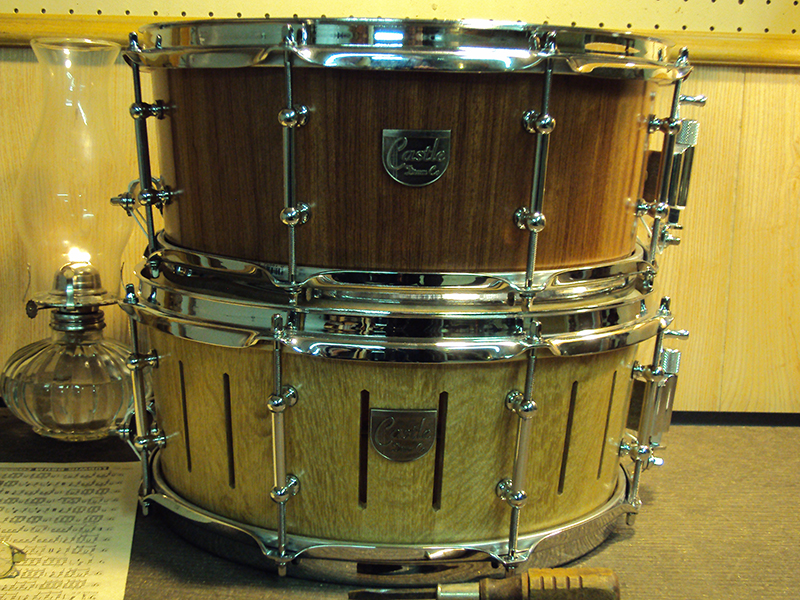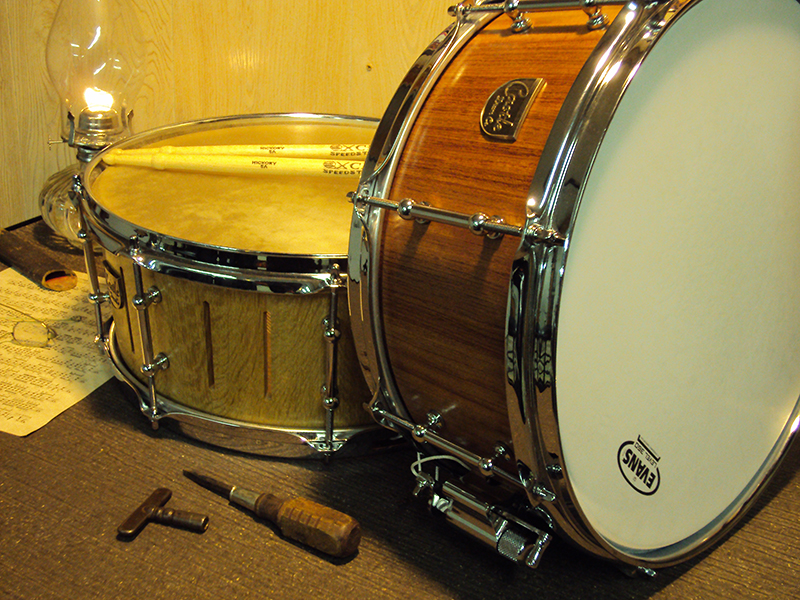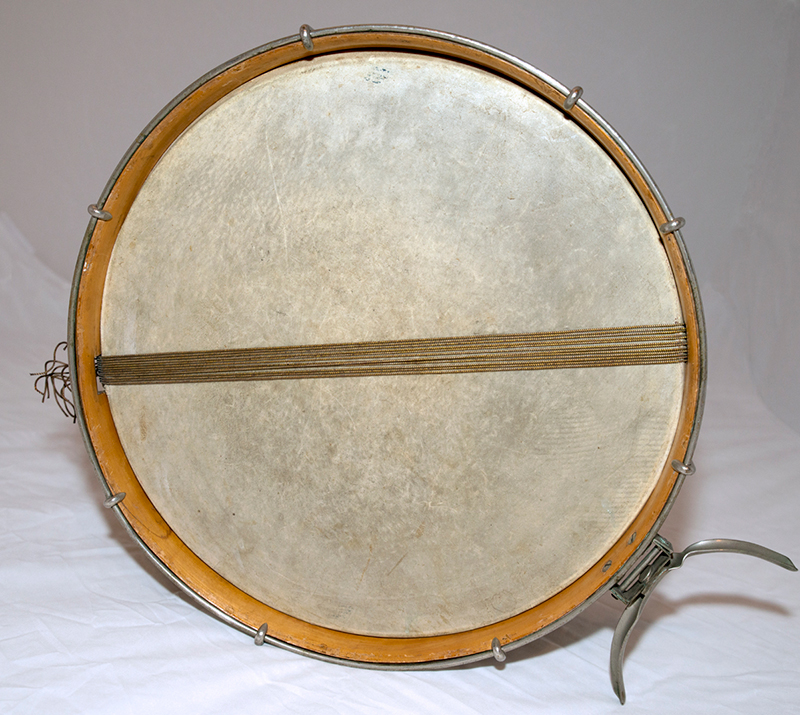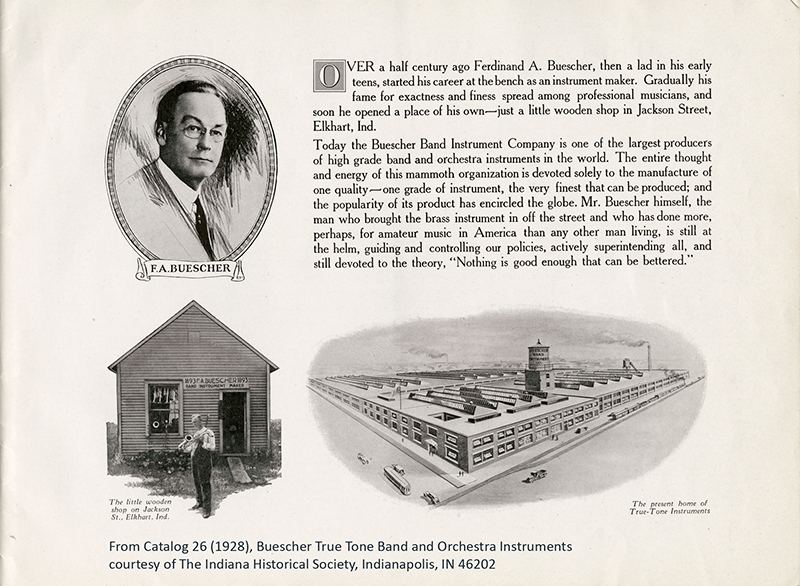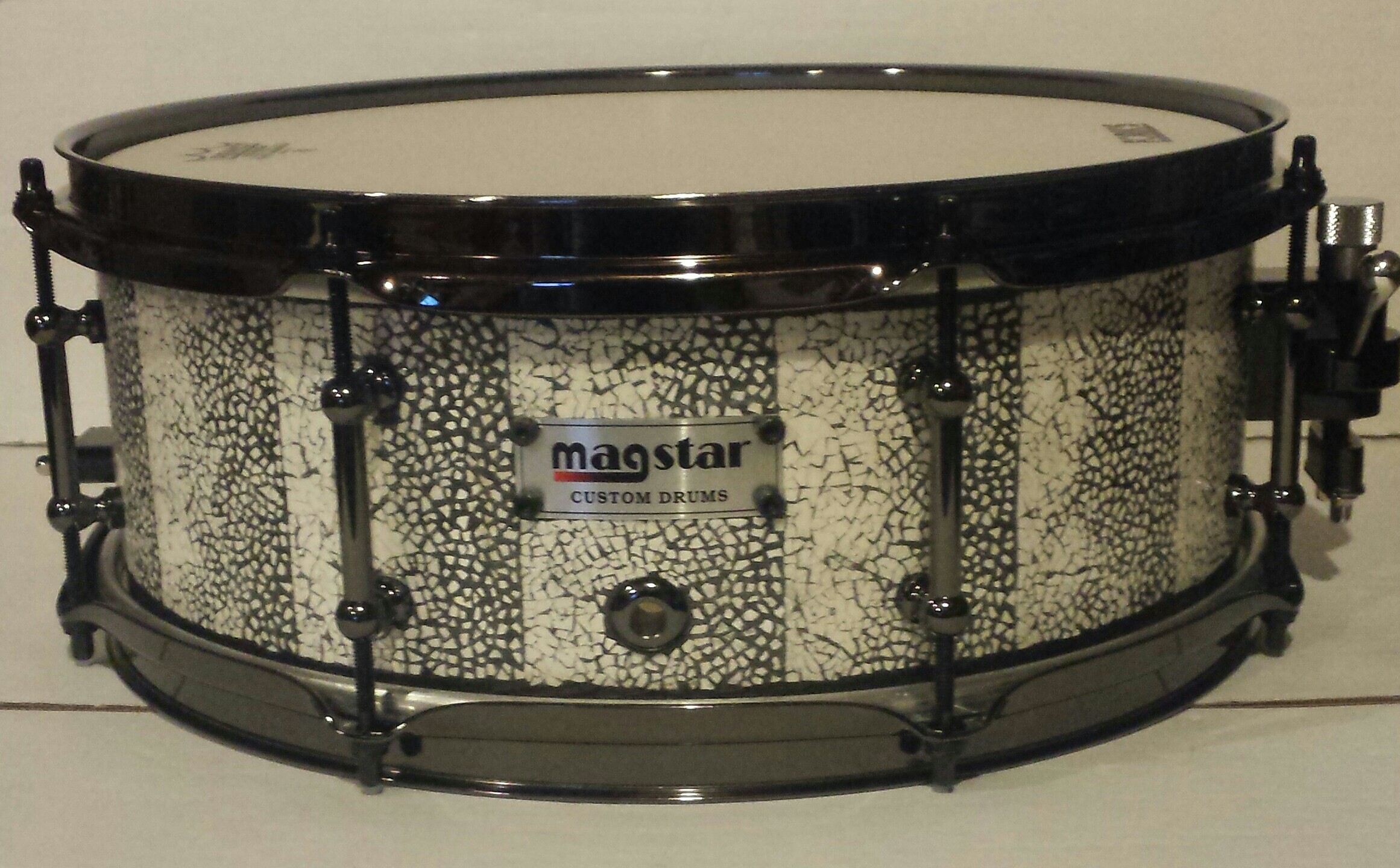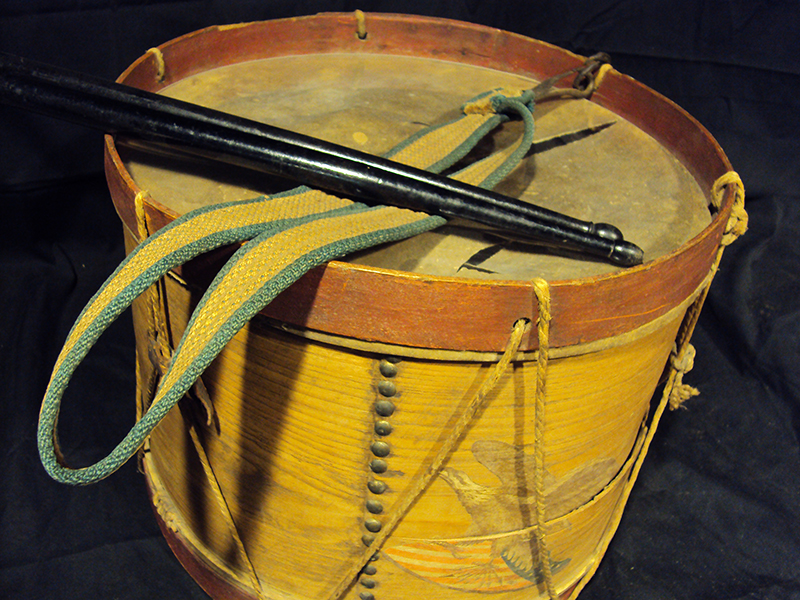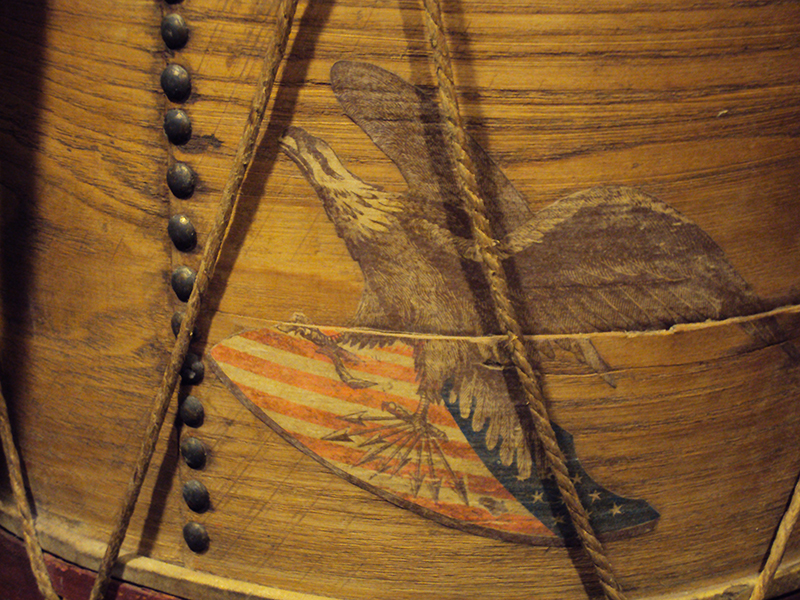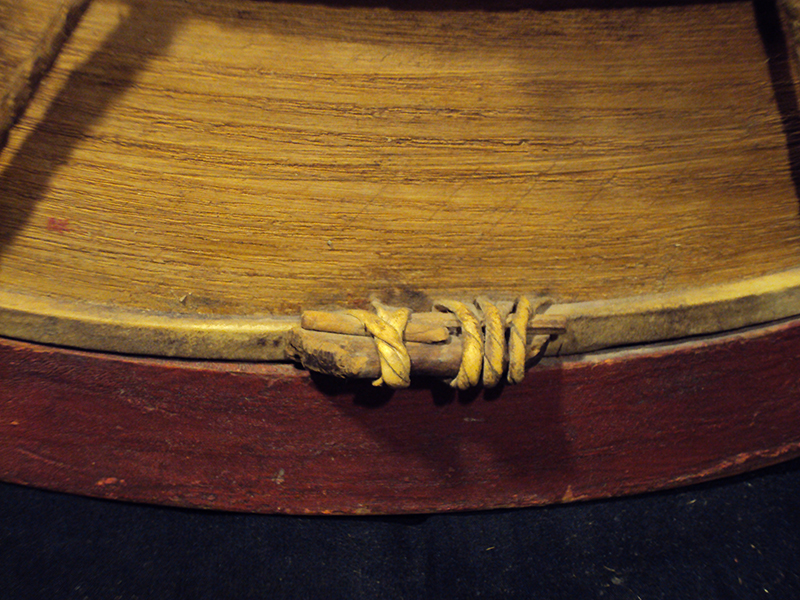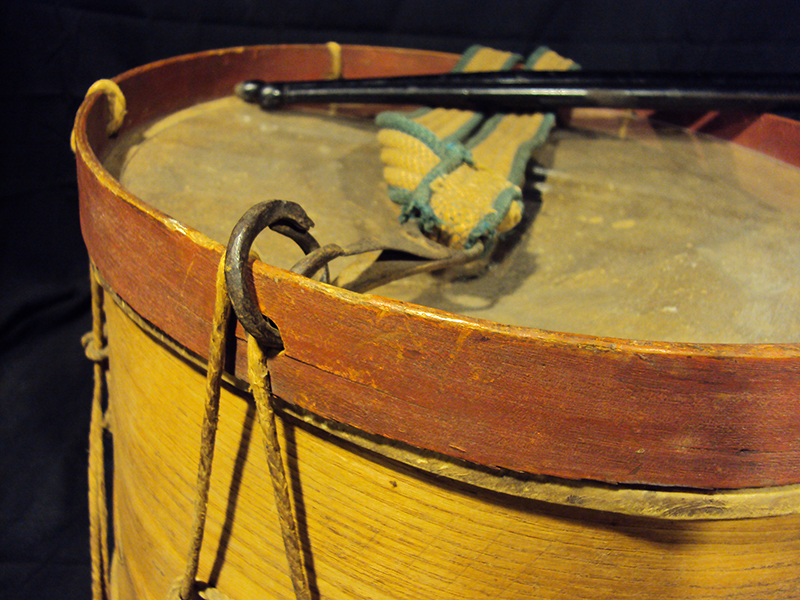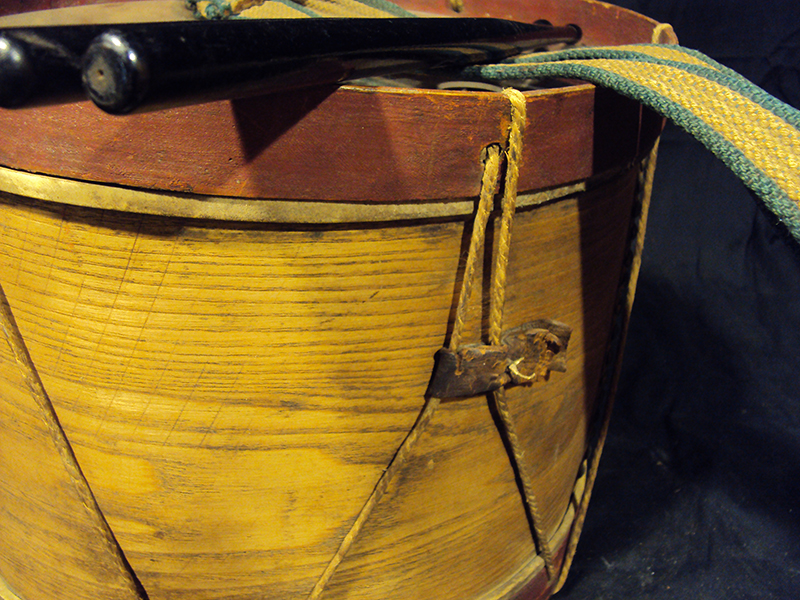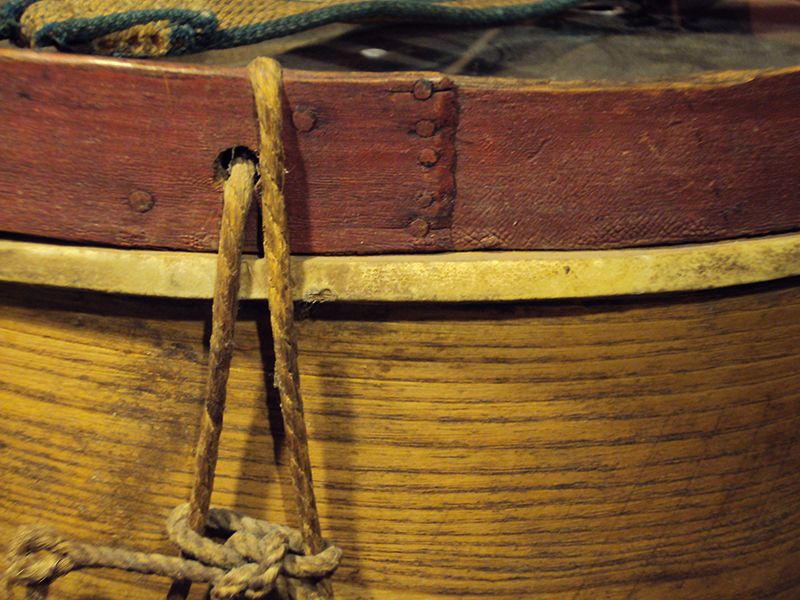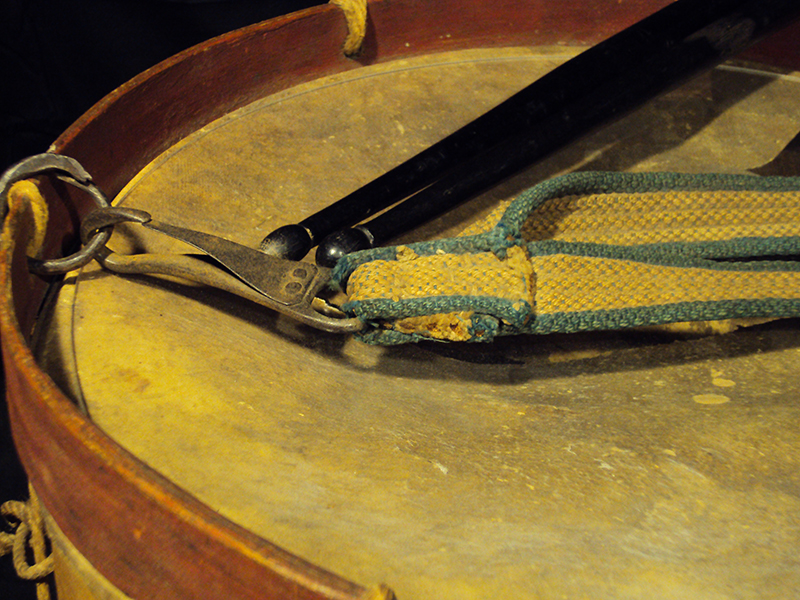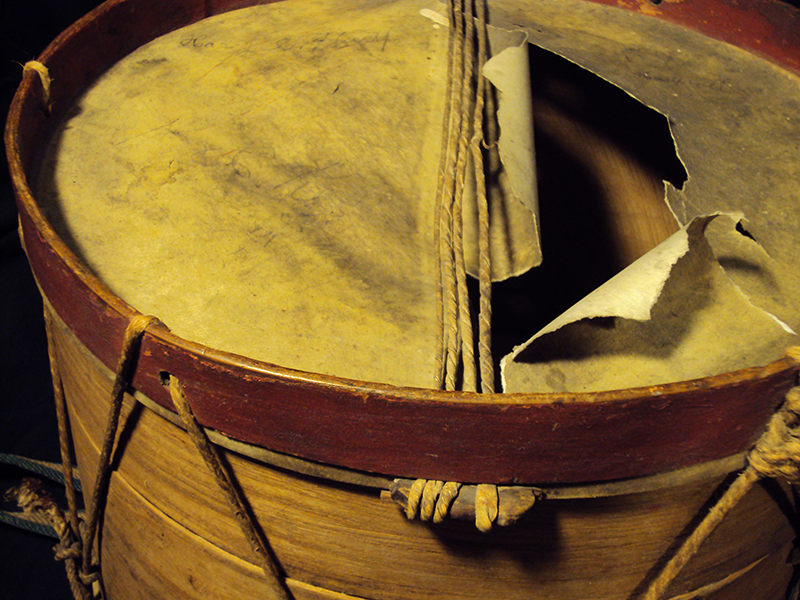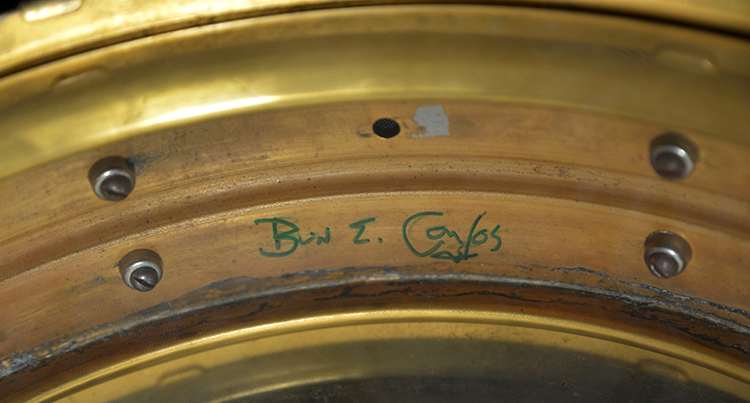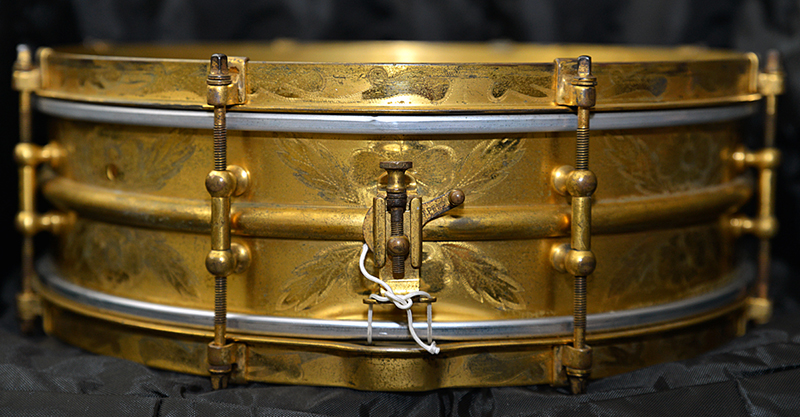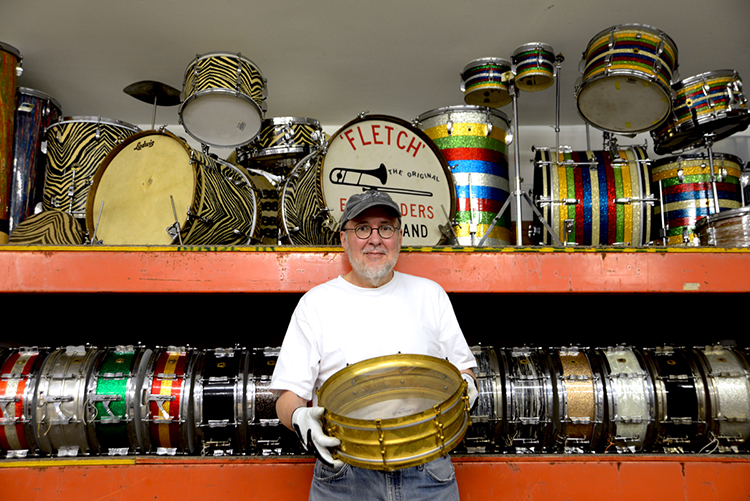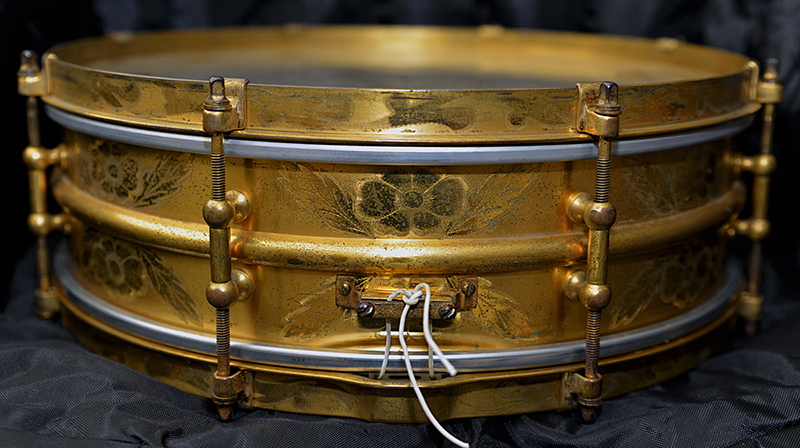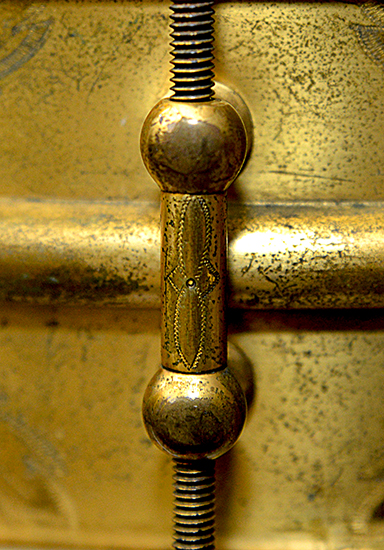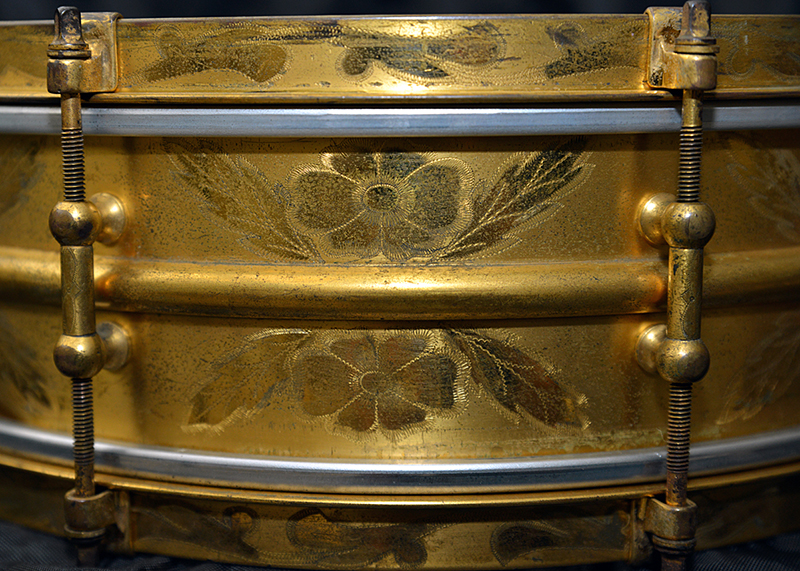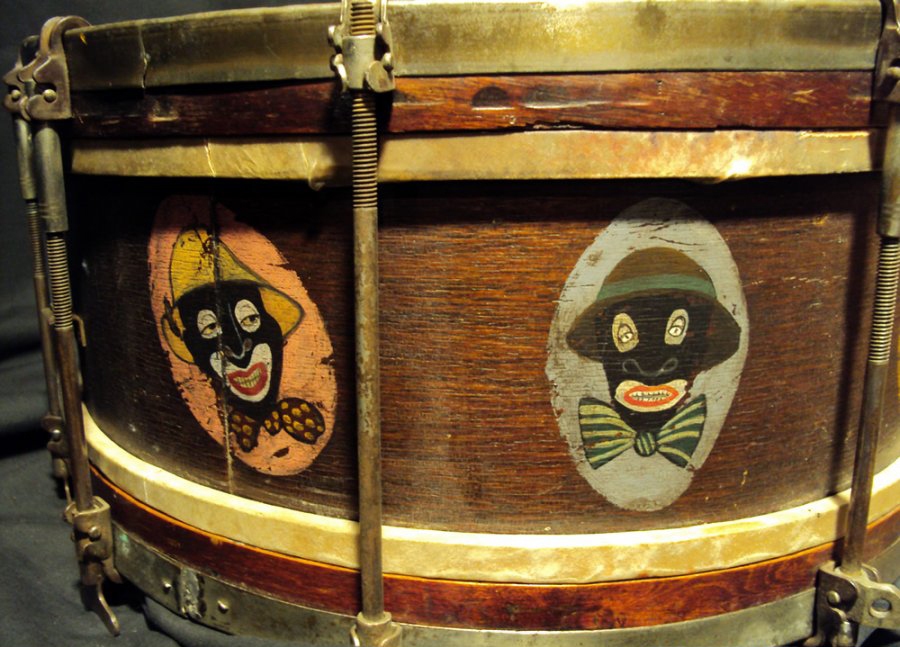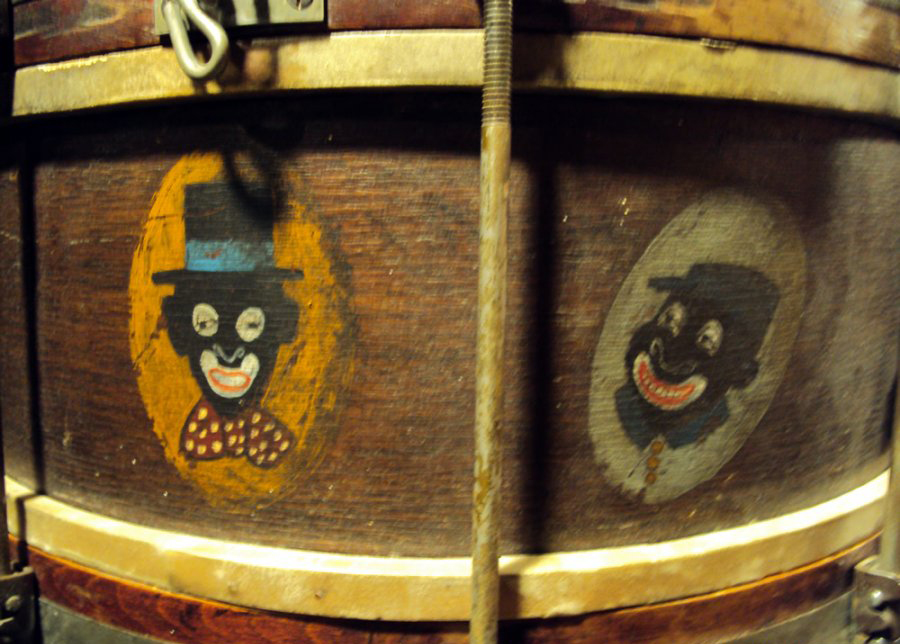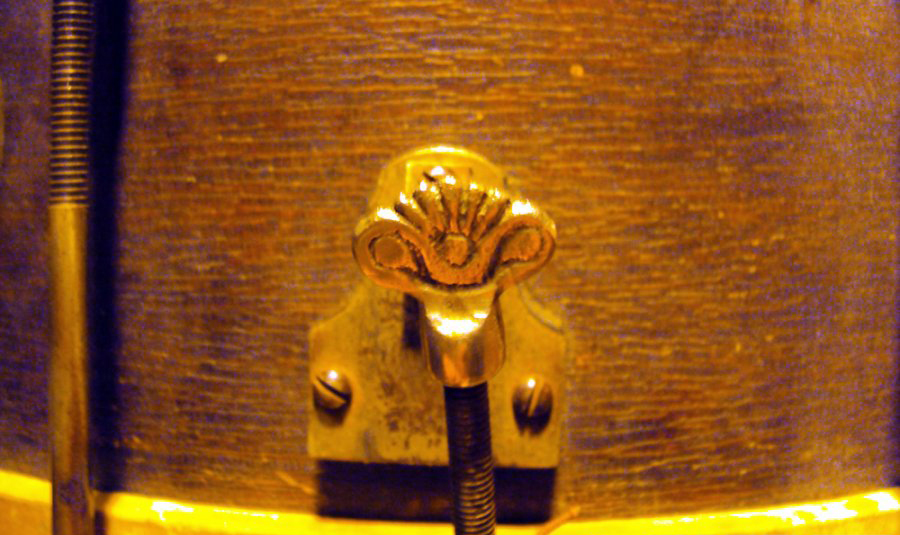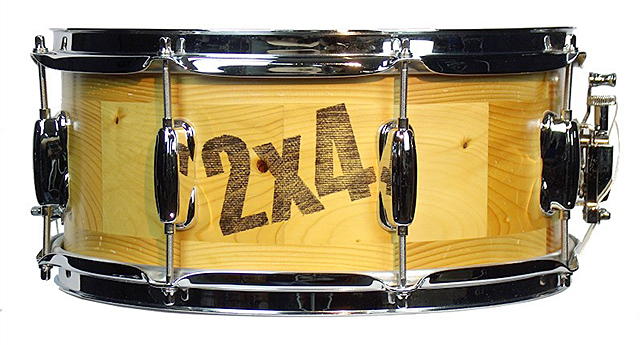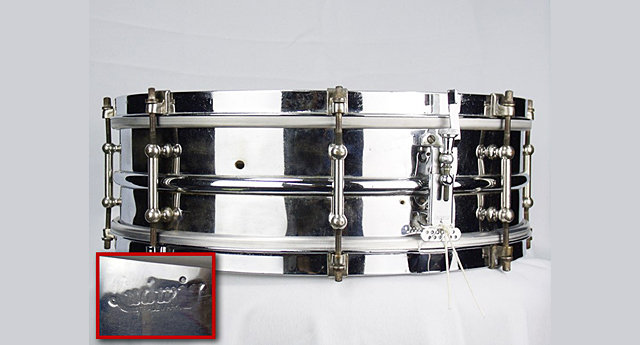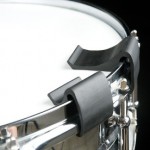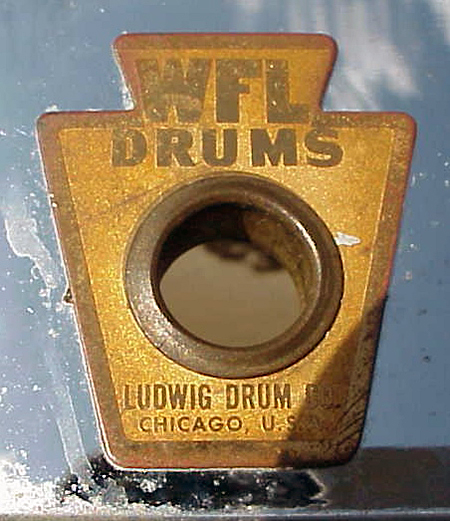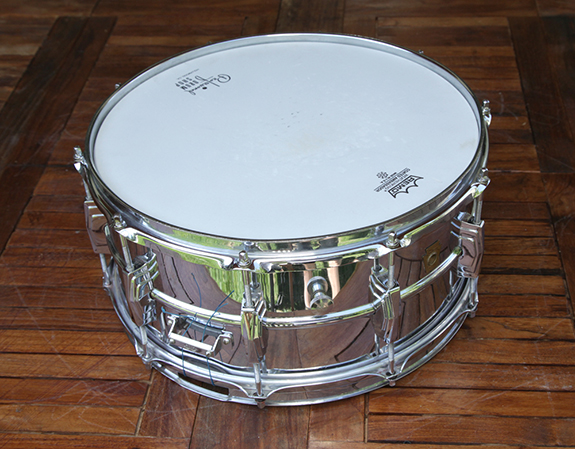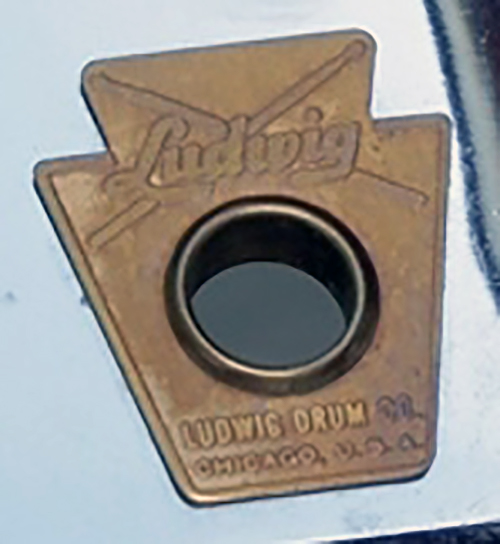Famous Drums' "2x4" Custom Snare Drum
Castle Drums
Growing up in the shop of a Master Craftsman and Industrial Arts teacher, my Dad taught me a lot about making and fixing things. I learned about metal, leather, printing, mechanical drawing, and woodworking, among many other things. But the most important thing he taught me was quality. While making my rounds at the Nashville Drum Show, I saw many drums that were made with top-notch quality. But even amongst all the quality instruments that were present, some stood out a little more than others.
As I approached the Castle Drum Company’s booth, I at first thought I needed to get more sleep because the drums seemed a bit skewed. Taking a closer look I realized that my vision was fine and the drums were indeed, a bit skewed. David Cheney, the Master Craftsman behind Castle Drums, had come up with something special and a bit different. David had spent over a quarter of a century in fine woodworking as a maker of cabinets, building case work and furniture. Working with odd shaped and intricate pieces, his ability dictated a higher level of thinking about wood and the possibilities therein.
As many of us find as we become older and more proficient in life, we tend to start to figure out what we like and how we want to spend our time. David decided at one point that combining his love of woodworking and drumming might pacify that angst. After all, drums certainly can be made of wood. The one thing that he knew was that he did not want to be just another guy out there painting and assembling drums: he wanted to set himself apart from the rest of the herd. For that, David would have to dare to be different.
Keeping some of the principles of basic physics in mind, he rationed that if you could channel the sound waves of the batter head down to the snare head in a more efficient manner, you would have a more resonant snare response. Turns out he was right. By funneling the sound waves by way of a slightly conically shaped shell, that energy would become somewhat concentrated onto the snare head. With the application a vertical stave construction shell, the grain of the wood is also in turn aiding in directing the flow of sound waves toward the bottom snare head. This inner vertical grain direction also contributes to providing a little “extra” in bringing out the low-end fundamentals of the shell.
David sent me two drums to review for Not So Modern Drummer magazine: The Keystone and the Watch Tower models. Both drums were very similar but couldn’t be more different in some respects. Each shell had a 7/16” thick stave construction, six inches deep with a fourteen inch batter head. However, the shell tapered down to a thirteen inch diameter for the bottom snare head.
David told me that they did some sound testing with results indicating an average of “20% more bottom head movement, and about three decibels more off the resonant (snare) head than other drums.” These drums are very snappy and produce a great snare response with lots of volume.
The hardware on each drum was chrome plated and included triple flanged hoops, an RCK throw-off and butt, as well as tube lugs. Snares were 16 strand and Evans heads were applied top and bottom. The vent hole was left un-reinforced. Both drums came with very nicely worked 45 degree bearing edges, but, for that “vintage sound,” rounded edges are offered on request.
This Keystone model is made of Bubinga wood, while the Watch Tower drum came in White Oak. Tung oil was applied to the inside of each shell while the outside is nicely lacquered. In playing with different tunings, I thought the Bubinga drum was considerably brighter than the White Oak. The Oak had a much more porous and open grain while the Bubinga was a very tight grained wood; thus resulting in the expected and predictable timbres of each shell. Both drums exhibited a wide tuning range, both high and low. As always, I switched out the plastic heads for pre-mounted calf-skin heads from CT Pro Percussion. The calf skins worked out really nice as they added that warm and earthy sound and feel they’re known for.
I find both drums exceedingly versatile in application. However, the main difference in the two models was that the Watch Tower model has a series of vertical slits in the shell. This plays well with another basic principle of the physics of sound associated with drum design and engineering. Drums are thought to usually project sound mostly from the top and the bottom heads, throwing the sound vertically up and down. They do, however, have an inherent tendency to throw the sound horizontally through the shell. In opening up the lateral sides of the shell via the slits, the Watch Tower drum distributes the sound in all directions. My initial reaction to this is that I think this particular model is exceptionally well suited to the environments of orchestra, concert band, jazz or any “un-miced” small group situations.
The Castle Drum Co. uses a variety of hardware to choose from and includes, but not limited to: RCK, Trick and Dunnett throw-offs, die cast and triple flanged hoops, a variety of lugs, snares and heads. Wood ranges from maple, white and red oak, birch, ash, and mahogany. For something special, try an exotic wood such as zebrawood, purple heart or bubinga. If David can find it, he just might build you your next favorite drum in your choices of dimension and hardware.
I find these drums are in fact fun to play and easy to tune. They tune like a fourteen inch drum but snap like a thirteen. The stick-to-head response is really nice, offering an ease in playing involved passages at lower volumes. Back-beats are exceeding fat and full of rich snare sound. Sensitivity of snare response at the lower volumes is again, very good. As far as the higher volumes: they’re loud!
One of the more surprising and pleasant characteristics of the solid shell was that the effective strike zone was at least double the diameter of most other drums I’ve played. This certainly makes the drum much more forgiving than many if a player tends to play with a wider, wilder strike-zone. The slotted shell (Watch Tower model) did not have quite as wide a strike-zone as the solid shell due to the characteristics inherent to the open design, but was still exceedingly responsive across the head non-the-less.
In examining the Keystone model made of Bubinga wood in particular, I had a very hard time locating the individual wood segments as the joints are tight and the grain is matched as close as possible. After giving these Castle Drums a good go, I would really like to take a look at the furniture David Cheney makes. If the quality is even close, I think anyone who has any of his work must be very pleased. The craftsmanship and quality on these drums is of a very high standard. David’s passion and enthusiasm is very evident and the pride he puts in each drum is extraordinary.
Take a minute and visit the Castle Drum Co. on line. There is a very well made video with David in the shop and more models and options to ponder. If you’re looking for something unique and well made with extreme snare sound and response, not-to-mention a really big, fat back-beat, these drums deserve some real consideration.
From Lancaster County, PA…....Thoughts from the Shop.
Brian Hill
1939-41 Leedy Broadway Standard "T-Bird" Engraved Snare
This was an easy one but I do have a restoration tip to pass along. This is purely personal but maybe a few restorers out there will find this useful. If you notice on all of my restorations you will see “aged” snare cord. I think that it looks out of place to have brand new white snare cord on an 85 year old drum; functionally it’s no problem, visually it drives me nuts. Here are two tips for you... 1. I use Yamaha snare cord model SNC-10 but before installing the snares I run the cords through a used (blackened) piece of Cape Cod Polishing Cloth, this darkens (antiques) the white cord and in my opinion makes it more realistic looking... 2. I just discovered Puresound makes model MS4 (dark brown brained line). This is what I used on the drum in this article.
Read moreThe Ludwig Silver Anniversary Standard Snare Drum(s)
In 1935, Ludwig & Ludwig celebrated its 25th, or “Silver”, anniversary. As stated in the Ludwig Drummer magazine of 1936, Ludwig & Ludwig was “Climaxing twenty-five years of supremacy” and introducing a “new sturdier shell construction: Ludwig All-Metal shells are spun from the best quality heavy-gauge brass with sturdy reinforcing bead in the middle, and edges are flanged and turned in against the inside wall of the shell for further strength and rigidity. The new heavy flanged counter hoops and modern design tension cases for the key tension lugs add both beauty and strength to the ‘Silver Anniversary’ models.” Ludwig offered these in brass or mahogany Super-Sensitive, Super-Ludwig, and Standard versions (5” X 14” and 6½” X 14” sizes). To me, the All-Metal brass snare drums were quite special as they had the newly introduced Silver Anniversary L&L badge, eight Imperial lugs (directly tapped, no inserts), heavy flanged hoops, and square bead in the middle of shell (although that was not always the case – read on…).
There is an aura which surrounds 1920s-30s Ludwig brass drums that continues to fascinate and thrill me. I’ve never heard one that didn’t sound terrific, and each has its own unique character. So I set my sights on obtaining one of these Silver Anniversary drums, and by a coincidence of fate, two Silver Anniversary L&L Standard snare drums came by my way: a 6½” X 14” and a 6½” X 15”. The 6½” X 14” was exactly as described in the 1936 Ludwig catalog, with the eight direct tapped Imperial lugs, square center bead, Professional strainer and nickel over brass finish. As you can imagine, one must be quite careful in not over-tightening the tension rods as you can strip the lugs, i.e., as they have no inserts. This drum was in good condition and sounded wonderful – great depth, projection and the rimshots and cross-stick off those heavy flanged hoops were to die for.
I was very impressed by this drum. About 6 months later, I came across a 6½” X 15” Silver Anniversary Standard snare drum for sale. I was a bit confused as the L&L 1936 catalog showed only a 14” being available, and in addition, this drum seemed to have a rounded center bead. I was starting to wonder if this was an authentic Silver Anniversary model. However, other than the size and bead contour, all else seemed identical to my 14” Silver Anniversary Standard. I did a bit of research and found that in the 1937 L&L catalog on page 6, there was additional fine print which said “see page 8 for special 6½” X 15” metal shell model”. So finally, on page 8, there was the 15” Standard snare and it showed a rounded center bead, although this was not specifically noted. The 6½” X 15” Standard Anniversary was “made in a special larger size recommended for large military concert bands because of its unusual volume and carrying power….made only on special, non-cancelable, non-returnable order.” So I had another wonderful L&L Silver Anniversary drum; this one with even a little more punch and depth. But the story does not end there…
It turns out that the 6½” X 15” Silver Anniversary drum was owned by none other than Ken Coomer, Nashville drummer and producer whose credits include Wilco, Clockhammer, Uncle Tupelo, Emmylou Harris, and Will Hogue to name a few. Ken was kind enough to share a little personal background on this drum.
“Here is a little history on the L&L snare drum. I purchased the drum from a pawn shop where Wilco bought a ton of different gear for recording and live. I knew it was something different, so I did some research and "presto chango" I find out that there may not be more than a handful of these know to exist, especially this unusual size. But, I would not have bought the drum if it sounded "like the box it came in." I have to be able to use a drum in some capacity. This drum had the first issue non- slotted (tapped) lugs. So you could strip them, and imagine where, if anywhere you could find the original parts. Early on I decided this was not going to be a road drum. But, I loved the tone, especially when I put the extra wide 42 strand Gretsch wires on - a great, sweet, sensitive snare drum.
I used this drum on Wilco's ‘Summerteeth’ and ‘Yankee Hotel Foxtrot’. I also think I used it on a Steve Earle track from a movie called ‘Side Tracks’... always loved a press roll on this drum!
Hope that helps some....I feel like this gives me some closure on parting with this drum, sounds silly, but I think you get it.”
Indeed Ken, I do very much get it. This is an amazing drum, an important part of your musical legacy, and a rare survivor of over 75 years. I will be a good caretaker and ensure that it continues to make music and endure.
So now I’m off to find another cool drum story… if you have any of the other Silver Anniversary snare drums, please let me know (fallendrummer@mac.com)!
Happy drumming! Never forget that we drummers are custodians of both our music and the stories behind the drums we play… If we do not share these stories, they will fade away and tragically be lost…
Special thanks to Mark Cooper for his invaluable assistance in the preparation of this article.
The Buescher True-Tone Snare Drum
While surfing eBay a few months ago, I came across an auction titled “Rare vintage Buescher marching snare drum.” The drum was 4” X 16” and looked like it had a brass shell. Around the vent hole, there was some nice engraving: “The Buescher, Elkhart, IN” and the serial number, “14157.” It had metal (possibly nickel plated) over wood hoops and what appeared to be the original calfskin heads (the bottom head had “True-Tone, Buescher Band Instruments stamped on it). The tension rods and hooks (8) looked very similar to an early 1920’s Nokes and Nicolai “Double Tension Rod Orchestra Drum” (for pic, click here), where both heads can be tensioned simultaneously by turning the tension rods with a square-slotted wrench, i.e., this requires one side of each lug to be reverse threaded. As such, this would qualify as one of the early free-floating shell designs. The strainer appeared quite different though. It was a bit more primitive, with a dual scalloped tensioning screw attached to the top hoop leading to a trapeze-like, triangular cable snare mounting bar. A leg rest was welded to the bottom hoop. Other than some well-worn heads and a bit of tarnish, the drum looked in rather good shape for being somewhere around 90 years old.
I was amazed that no one was bidding on the drum. This was drum history and needed to be preserved. At least that’s the reason I gave to my wife when I bought it…
The story behind this drum begins with a man named Ferdinand August “Gus” Buescher (pronounced “Bisher”), born in Ohio on April 26, 1861; two weeks after Confederate forces fired upon Fort Sumter to start the American Civil War. Buescher worked for C. G. Conn in his band instrument factory from 1876-1894, rising to the ranks of foreman but clearly aspiring for something greater. In the fall of 1894, he opened up his own band instrument factory and metal shop on in Elkhart calling it the Buescher Manufacturing Company. In the preface of the Buescher catalogs, it is written: “… Ferdinand A. Buescher then a lad (then a young mechanic) in his early teens, started his career at the bench as an instrument maker. Gradually, his fame for exactness and fitness spread among professional musicians, and soon he opened a place of his own – just a little wooden shop in Jackson Street, Elkhart, Indiana.” Beuscher’s workplace motto was “Nothing is good enough that can be bettered.”
In 1903, there was an unfortunate bank failure that put Buescher in an unfortunate financial position. One year later, he was forced to reorganize the business, restricting it to only producing band instruments, and renamed it the Buescher Band Instrument Company. In 1916 at age 55, Buescher sold a majority stake in his company to six wealthy businessmen. Ten years later, the Buescher Band Instrument Company was absorbed by the Elkhart Band Instrument Company (it is unclear if this was a merger or buyout). Andrew Beardsley, the president of Buescher, and Carl Greenleaf, the president of C. G. Conn, founded the Elkhart Band Company just three years before. Buescher resigned eventually in 1929 but stayed on as a consultant engineer. He died in Elkhart, Indiana on November 29, 1937 at the age of 76. Buescher’s legacy lived on, most notably in form of his TrueTone horns, which are highly collectible and sought after today. Unfortunately, his contributions to our drum heritage were not as well acknowledged, perhaps as they were eclipsed by Conn, Leedy and Ludwig.
One side note: the name Buescher seemed familiar to me but I couldn’t place it at first. George Way leased the Leedy factory building, originally known as the Buescher Building, in 1954 to start production for the George Way Drum Company. In 1963, Buescher was sold to H.A. Selmer, which later became Conn-Selmer, Inc. whose residence remains at 1119 N. Main Street in Elkhart today. So throughout the annals of drum history, the names Buescher, Conn, Leedy, Way and Conn-Selmer (Ludwig) have been connected.
So fast-forward to today and here I am with one of the only examples of a Buescher snare drum that remain. I contacted Harry Cangany and he had not seen one previously. I did my best to find any surviving copies of Beuscher Band Instrument catalogs to identify the drum more specifically. In the 1909 Buescher catalog (see picture), a “#100 True-Tone snare drum for band and orchestra” is shown as being available in either 6” X 16” or 8” X 16” sizes with “two finest calf-skin heads, hoops brass-capped, 16 solid brass tighteners with belt hook, knee rest and 12 waterproof snares.” The options included a “metal shell, highly polished brass” for $15.00.
Now my drum looks extremely similar to the 1909 version, but with subtle differences:
- Only 8 lugs (perhaps the other 8 were removed for convenience? These lugs are not fun to remove…or perhaps a subsequent 8-lug model?),
- 4” shell depth, although it is 6” if you include the hoops,
- Tthe thumb-screw for the strainer pictured appears to have only one scallop, whereas mine has two, and...
- The hoops are not brass capped but seem to be a nickel-plated metal.
According to on-line Buescher serial number guides, the drum (#14157) may have been manufactured between 1911-1912. I located a 1915 TrueTone Drums and Traps catalog at the Indiana Historical Society and found that the Buescher drums had since evolved to either thumb-screw tensioning or center-mounted lugs on the shell. Therefore, it seems plausible that this drum preceded 1915 and was a variant of the close relative pictured in the 1909 catalog. If anyone out there has a Buescher Drums and Traps catalog from 1910-1914, please let me know!
I hope this beautifully engraved Buescher snare drum and short narrative will help you remember Ferdinand Buescher and pass this information down to our next generation of drummers. Until next month, best wishes from this humble student of drum history…
The Eggstar Drum
EGGSCITING DESIGN EGGCELLENT SOUND EGGSPERT CRAFTSMANSHIP
The idea for this drum first came to me many years ago while watching my mom, Lola Rokeach, refinish a table with eggshells. Yes, actual eggshells! The finish looked very striking to me, and I thought that it would look pretty cool on a drum.When I mentioned it to her about a year ago, her response was "Well, bring me a drum." My mom, in addition to raising eight kids, is quite an accomplished artist. She's done everything from sculpture, to painting, to rug making, and oh yes, furniture refinishing. She celebrated her 80th birthday last June. She was pretty confident that the eggshell finish would work on a drum. I wasn't so sure, but I thought that it would be worth a try.
I didn't want to use just any old drum. I had to get something special. I'm a Yamaha endorser, but I didn't want to bug them about doing a custom made one-off that might or might not work anyway. Besides, I was thinking about a single--ply solid shell for this project, and Yamaha has yet to offer one (I hope that they do someday). I did want to get someone involved who knew something about drum finishes.My mom lives just outside of New York City in the small town of Harrington Park, NJ. On one of my recent trips back there, I visited my old friend Neil Richter, also a drummer, also from Harrington Park, NJ. He told me that he had recently reconnected with yet another drummer from Harrington Park, Rob Kampa. Readers of this newsletter may know about Rob from his drum company Magstar, and his work with DrumMaker. Rob is known as one of the best drum craftsmen in the country. I had read rave reviews of Rob's custom drums over the years, in Modern Drummer magazine and on the internet. I also knew Rob when I was a kid.Between Fall of 1969 and Spring of 1970, I played in the percussion section of the Harrington Park School band with Neil and Rob. They were in eighth grade, I was in fifth. Rob, Neil, and another Harrington Park drummer named Mike Murtaugh, who was already in high school by this time, were the best drummers around. I thought that those guys were about the coolest dudes that ever lived. Getting to hang out with them definitely helped plant the seeds of my desire to be a drummer early on.Rob has been living in Nashville for the past few years, but still gets up to New Jersey every once in a while to visit family.
The more I thought about it, the more I came to realize that Rob would be the perfect guy to help make this happen, If he'd be willing. He could even get together with my mom and figure out the woodworking logistics if necessary. Well, Rob and I reconnected on the phone. Once we got to talking about drums, we decided to order a 5.5 x 14 solid shell from Vaughncraft. Vaughncraft sent a shell that was so beautifully figured that it would have been a crime to cover up the wood grain. I loved the shell but had planned to let it go. My wife and two daughters knew how much I hated to let that amazing shell go. They decided to have Rob build it for me as a Christmas present. So Rob built an incredible drum with a beautiful soft gloss finish, ten tube lugs, and a trick strainer. It looks and sounds fantastic. Merry Christmas!But we were still left with the task of finding a shell for the egg drum. We didn't want to order another solid shell. It seemed crazy to ask for one that was crappy-looking so that we could cover it. So we decided to use one of Rob's eight-ply Keller shells that he had already stained black. I had heard great things about Rob's multi-ply drums. This seemed to make the most sense. I had sent Rob some photos of a table that my mom had done her eggshell magic on. After seeing the photos, he suggested that we use black hardware for contrast.He sent the shell up to my mom in New Jersey. I still wasn't sure if the eggshell thing was going to work on a drum. I could tell that Rob was a bit skeptical too. My mom seemed to be the only one who was sure that it would work.She got going on it. Eggshells-- lots of eggshells, Elmer's glue, and ten coats of varnish. I was worried that the eggshells might be easily knocked off, but she told me, "Those eggshells aren't going anywhere."
Then she sent it back to Rob. He put all of the hardware on, and here it is. The drum has eight tube lugs, triple flanged hoops, forty-five degree bearing edges, and a trick strainer. The EGGSTAR has been hatched! It sounds great and looks eggstraordinary! It's got plenty of crack, and it's high in calcium too!I'm eggstatic about it!
-Dave Rokeach
David RokeachDavid Rokeach is a freelance drummer in the San Francisco Bay Area. He has played with Ray Charles, Aretha Franklin, Charlie Musselwhite, Mark Murphy, Rita Moreno, Merl Saunders, Aaron Neville, Patti Labelle,The Rubinoos, The Broadway Show Jersey Boys, Holly Near,and many others. He has been a faculty member at Jazz Camp West, The Stanford Jazz Workshop, Lafayette Summer Music Camp and The Jazzschool in Berekeley. You can visit his website at www.davidrokeach.com.
MBW Drums Sleeping Beauty 6.5x14 Aluminum Snare Drum
What separates one drum builder’s instrument from another? We used to say it was unique lugs or a unique badge, but there are so many independent drum builders out there now and so many drums on the market it is getting hard to tell them apart. So it always comes down to tone, doesn’t it? How does the drum sound? How does it feel to play it? Is it just another pretty face or does it stand out from the crowd when you hit it? Does it light up the eyes and the ears? Michael Bouvier of MBW drums has a new model that is one of the best sounding snare drums I’ve ever heard, and it’s also a beauty; a “Sleeping Beauty”.
The 6.5 x 14 shell is a thin aluminum straight cylinder with no bearing edge flanges. The bearing edge is a single forty five degree cut to the inside with a slight round over on the outside. The snare beds are deep and wide which cuts down on buzzing.
The finish on the shell is classy and elegant - weathered aluminum with copper vein patina. It’s a completely hand finished effect. No two will be exactly alike. The hardware is all brass; 2.5mm brass single-flange hoops, full length brass tube lugs and a George Way type, hand turned brass beer tap throw off with détente tension settings, all weathered by hand and sealed to protect the finish. The aging and weathering of the finish is so realistic that, at first glance, this drum appears to be a very old vintage drum.
Sound: When I first started tapping and hitting this “Sleeping Beauty” snare drum, I thought I might be over reacting because it was the first drum I had heard that day. It sounded phenomenally great but I wanted to be sure of what I was hearing. So I went around the Drum Room and hit some of my first string and holy grail snares as a point of reference.
My ears were not deceiving me. This drum has some serious, serious tone and it is elegantly beautiful to boot. Several of my pro students came in a little later and had the same reaction and opinion.
I don’t like to use over used words like “crack”, “loud”, etc. to describe drum sounds. The first word that came to mind with this drum was “rich”. The fundamental tone is very evident with a nice blend of shell overtones and just enough head ring to give it a little sustain, even with the Evans Dry head. Combined with its very even snare response, it produces a nice throaty “honk” that I like to hear out of a metal drum. Rim shots have a nice, tight pop or snap to then. The snares responded perfectly from the center to the edge of the head. It came tuned to a medium high note and was very easy to tune down into the “fat” tuning area. Nice big, low sound at that low tuning. The very high tuning was very good – no choking and it gave a nice loud report when I laid into it at triple forte. The drum feels really good to the hands. It is a pleasure to play.
I have a drum track overdub recording session tomorrow in the Drum Room with a name artist and this will be the first snare I will pull out. It would surprise me if they want me to change it out for something different. I’ll report back about that.
The judges’ decision? A solid ten. This “Sleeping Beauty” (love the name) is a keeper. This one is already sold and I am going to miss this one when I have to give it back. I might have to buy one of my own. I really think this falls in the category of a “go to” drum. Each drum will ship with and Evans HD Dry batter, Evans 300 Hazy reso and Puresound Super 30 wires. The snare I reviewed is a 6.5x14. Any size of this model, form 5x14 – 8x14, is sold for $795 shipped anywhere in the continental US.
Additional charges may apply for overseas. Michael says these he has these shells made in any size all the way up to bass drum diameters. Pricing varies on the snares depending on other diameters.
Contact Information:
Michael Bouvier at MBW michael@mbwdrums.com www.mbwdrums.com
Too Young To Die
Maker: UnknownCirca: 1855-1861 Dimensions: 9”(h) x 13”(dia.)
Drums have been moving creatures into dance and trance since the first rhythms were beat out of an audible object. The rhythms were a natural extension of ourselves; pulsing from our very core and starting with our own heart beats. With the modern inspiration that came at times from catalysts such as the “Ringo effect” or the impact of the likes of Gene Krupa, youngsters have always thought that drums were the coolest! Like most young boys, the generations of the early and mid 1800s, were visibly excited by the sight and sound of martial music propelled by the drums of the drum corps.
Nothing could instill a child with more pride and inspiration than being an accomplished drummer, and nothing short of a grand adventure could propel them to enlist faster.
From the very beginning, the American military has had a long history of recruiting young boys in time of hostilities. In the years following the American Revolution, military and governmental officials tried earnestly to rid the Army of the many under-aged boys that previously helped fill the ranks of the fledgling armed forces that eventually won the war. Over the next several decades the regulations on minimum requirements ebbed and flowed with the changing circumstances of building the new Republic. Regulations for the minimum age and height were always of a lower standard for musicians. Local and state militia units often ignored these regulations for musicians as most were just glad to have them along. Many under aged lads simply accompanied their fathers into the ranks or were orphaned and simply needed a place in the community.
By the time of the Civil War, the minimum age for an enlisted man was eighteen years, with a height requirement of at least five feet, four and a half inches. However, a musician could be enlisted as young as twelve years with no minimum height requirement. As would be expected, many underage boys simply lied about their age in order to enlist, skewing the records forever. Of the records of those who did not lie about their age, we know that there were at least three hundred boys 13 years old and under enlisted in the Union army during the Civil War, and at least 25 who were ten years old or younger.
Two of the younger enlisted drummers were eight year old Avery Brown of Company C, 31st Ohio who, two decades later, billed himself as “The Drummer Boy of the Cumberland”. Also there was 9 year old Albert C. White who accompanied his father, Lt. Cornelius C. White, into the ranks of Company D, 64th Ohio. Disease, hardships, and the casualty of battle would shorten the tenure of many of these small adventurers as they would not last 3 month, but the lot of them stayed the course and even reenlisted for the duration of the War.
Despite the sometimes romanticized idea of all these young drummer boys in the Army, most were never allowed even close to a recruiting officer. They were encouraged to find a “gig” on the home front. These young wizards of the drum were highly sought after…..and the younger the better. P.T. Barnum’s famed New York City museum regularly employed exceptionally talented young drummers during the War. Two of the most notable were Major Willie Bagley and Master Allie Turner, both four years old.
This drum was made shortly before the War started in 1861, during a time of extreme patriotism, and is a miniature version of a full sized military drum. With the War now a reality, production of this type of luxury item would no longer be practical, as most manufacturing would have been concentrated on the war effort. Commonly referred to as a child’s drum, rather than a toy, it sports many of the same features found on a regular sized military drum. The shell is a varnished, single ply of thin ash veneer with red sponged maple counter hoops. A single row of vertical brass tacks reinforce the outer edge of the scarf joint. The central figure of the drum is a decal of an eagle standing on a patriotic shield that was a very popular design from 1855to 1865. However, this type of design was also used decades before and was still in use on drums through the end of the century.
The original cat-gut snares remain and are simply wrapped around a piece of wood that acts as a snare butt and pinched between the hoop and shell opposite to create the tension. The ruptured heads are made of a parchment material very similar to heavy paper and glued to the flesh hoops. Only one leather ear is left present on the drum as the others have long since deteriorated from time and use. The hemp rope is tattered, but also original.
Written on the bottom head in pencil is the name: Harry C. Hartfence. Harry, quite possibly the original owner, may have received this drum as a gift. With the condition of the drum and the fact of the manner in which it was made, especially the condition of the heads and no repairs evident, the probability of a young Harry being the original owner makes good sense. No records indicate he was in the army during the Civil War.
Included with the drum is a very rare, child sized cloth drum sling, which is in very good condition. It is attached to the drum with an equally rare wrought iron sling attachment ring, which is run through one of the rope holes. It seems there was no standard with which to attach the sling to the drum….each drummer or manufacturer had his own way of accomplishing this task. A nice pair of black, under-sized drum sticks round out this grouping.
The drum remains original and untouched; sometimes referred to as “relic or farm-fresh” condition. Only a light cleaning was needed. The shell has a crack that runs about half way around the center of the drum and may be the victim of the inexpensive manner in which it was constructed as well as the lack of reinforcement at the scarf joint area. After all, it was only a child’s drum but, nonetheless, a silent testament to the patriotic zeal and seemingly ever present desire of youngsters to make the music. This small instrument was certainly made for those who had to stay behind…..…those too young to die.
From Lancaster County, PA... thoughts from the Shop.
-Brian Hill
Bob Campbell's 1920s Ludwig & Ludwig Wild Rose Triumphal
The Robert M. Campbell Collection - “1920’s Ludwig & Ludwig 4 X 14” Wild Rose pattern engraved, gold-plated Triumphal, Standard Model” - by Robert “Bob” Campbell
As a collector, there are those “holy grail” or “desert island” snares that you hope one day to find, and with some good luck and sufficient cash, possibly own. At the 2013 Chicago Drum Show, I had the good fortune to be seated next to Bun E. Carlos during the filming of a Vintage Drums Talk segment by Jim Messina, www.vintagedrumstalk.com, www.youtube.com/watch?v=YrOuznVG2ZU). I’m not sure how the conversation started but Bun E. began telling me some stories about the legendary Charlie Donnelly (Connecticut drum store owner and vintage drum expert who Steve Maxwell credits as “the person responsible for jump-starting me down the path of vintage drums.”) This progressed to talk of our collections. I mentioned that I had purchased a Ludwig 1928 Gold Triumphal 100th Anniversary Reissue from Steve Maxwell. However, I said, “I really wanted an original 1920’s Ludwig & Ludwig Triumphal.”
To my surprise, Bun E. said something like, “I have one that I might sell. Are you seriously interested?” I, of course, replied with a most eloquent answer, “Umm, really?” So then and there, we made a deal.
Bun E. kindly invited me to pick up the drum at his storage barn. His amazing, expansive collection is a story for another time but I did get the Triumphal, signed by Bun E. on the inside of the shell.
I was very curious about the history of the drum and asked Bun E. for some background information. He referred me to Steve Maxwell, who originally acquired this Ludwig & Ludwig Triumphal. Steve said the fellow who had the drum obtained it in Chicago from his teacher in the 1950’s. He didn’t play it much then because it was “so nice”. When the seller contacted Steve, he hadn't played in 20 years and wanted to see how much it was worth. Steve provided this interesting account of how this unique, historic drum serendipitously came into his shop:
“I get a call out of the blue from a guy who says he has a metal Ludwig rare drum and since he's in his 70s and living on social security he figures he might as well try to sell it and see if it's worth a few dollars. I asked him to describe it and he told me it was a 1920’s Ludwig. He thinks it's a 5", then again maybe a 4x14”; and he said it was engraved. So, I assume he's talking about a regular Black Beauty, so I ask if the shell is black with engraving showing through, and he says, "No, it's a gold color". So, now I figure that he's got a stripped shell that was originally an engraved black beauty since we see that sort of thing from time to time, and therefore value is a lot lower. So, I ask him about the engraving pattern and if it is floral (and I describe the typical 10-point and 12-point floral) and he says "no". So I describe the typical scroll pattern and again he says "no". So I ask him what the pattern looks like and he says, "it's sort of like a flower". Now, the LAST thing I am thinking is that this might be another Wild Rose pattern Triumphal. I simply figure that he has a 1920’s era Standard that may have been nickel over brass, non-engraved; and I figure someone stripped it, polished the shell, and did a home-made engraving job. So, I tell the fellow to bring it in and I'll have a look. In the back of my mind, I'm thinking that this is maybe a $500-$700 player's drum. However, I didn't say that because I didn't want to disappoint him. So I figured I should just keep quiet until I actually saw the drum.
About a week later, he comes into my store with a drum case. I opened the case and just about passed out on the spot! Looking up from the case was an absolutely incredible 4x14” 1920’s era Wild Rose pattern Ludwig Triumphal. I told the guy to sit down because we had to have a serious talk here...
I pulled out Mike Curotto's book (Vintage Snare Drums: The Curotto Collection, Volume I) and turned to the page where Mike describes his Wild Rose, the only one that ever surfaced. I tell the guy that his drum is now only the second one in this pattern that has surfaced, and in fact is now the 8th Triumphal since only 7 other examples overall are known to exist.
As I mentioned in an email to Bun E, I could have bought this drum from the guy for a song since he needed cash, but I encouraged him to let me broker it on consignment so that he'd get a significantly higher amount than if I were to buy it outright. I told him that I felt we could move the drum fairly quickly for him. Then I told him what I thought we could get for the drum, and he almost passed out! He agreed to consignment so I then contacted Bun E and a few other people who I knew would be interested. Bun E grabbed it immediately. I delivered it to him in person, and the rest is history. It was a nice deal all around because the transaction was really life changing for the seller, and the drum went to someone who appreciated it (Bun E.), and now it's in your hands, which is great.” Many thanks to Steve for providing this wonderful story… Now if I could only find out who was the original owner prior to the 1950’s!
I am an avid believer that our drum history needs to be preserved and handed down to the next generation before it is lost forever. I am merely the custodian of this drum until it passes to the next owner. While I could not get the exact provenance of this Triumphal, I have captured all that I know in this article. If anyone has any information about the origins of this drum (or questions), please feel free to contact me at fallendrummer@me.com.
Brief background on the Ludwig and Ludwig Triumphal snare drum:
The Ludwig & Ludwig Triumphal snare drums were truly exceptional in their day, coincidentally only a few years before the great Stock Market crash of 1929 (e.g., 1925-1928). They were the pinnacle of drum making; gold-plated and ornately hand-engraved on the shell, hoops and even the lugs. My drum is indeed a 4 X14”, 8-lug gold-plated, engraved Ludwig & Ludwig Triumphal Standard Model with the Wild Rose pattern. The center-beaded, two-piece soldered shell is quite heavy for a 4 X14” (although I guess not atypical for brass shell drums of the period). As noted by John Aldridge in his “Guide to Vintage Drums”, the Triumphal like Black Beauties of the period had an air chamber inside the bearing edge, i.e., formed by bending back the last ½ inch of bearing edge at a 90 degree angle and soldering it to the shell. Upon close inspection, I did not find a weld so assume this is a spun brass shell. To date, it is only the second known to exist with the Wild Rose pattern and perhaps only 1 of 8 total Triumphals that have survived.
Acknowledgements: Many thanks to Steve Maxwell, Bun E. Carlos and Mike Curotto for all the input, encouragement and shared wisdom.
Ludwig & Ludwig New-Era Sensitive DeLuxe
Hi All,
The Ludwig & Ludwig New-Era Sensitive DeLuxe Model is extremely rare. There are only 4 known examples as of this writing. These 4 known examples are all accounted for: The first example is in the University of Mississippi Museum, the second example is in a private collection in the eastern part of this country, the third example resides in my collection and the 4th and most recent example known to exist in now in the Robert Campbell Collection.
I first heard of this drum from my good friend John Aldridge. Aside from being a vintage drum historian, a world class engraver and an all around plethora of knowledge, John is also the drum tech for the previous owner of this drum, Bryan Hitt of REO Speedwagon. The drum was definitely “ridden hard and put up wet” but it was still a diamond in the rough. I already have one of these drums but I couldn’t stand the thought of letting this drum fall by the wayside so the “drum rescuer” in me set out to bring this drum back to life. Robert Campbell buys high end snare drums so I presented the idea of getting this drum restored and getting it into Robert’s collection. It was a pretty easy sell as I truly feel that this drum was worth the effort.
This model never made it to a Ludwig & Ludwig catalog and the only mention of the New-Era Sensitive model is in the Fall 1929 Ludwig Drummer Magazine.
1929-30 LUDWIG & LUDWIG 5 x 14 NEW-ERA SENSITIVE DeLUXE (BLACK BEAUTY) MODEL
THE SHELL:
The engraving is the 1929-only 10-point flat-top double-leaf floral pattern. The shell was in good shape with no major digs or dents but the original clear coat lacquer was in bad shape so I stripped the original lacquer down to the black nickel. After cleaning and polishing the black nickel I took the shell to Brian at Avenue Plating for a new lacquer clear coat. The shell came out great, looks clean but still looks its age. At some point there was a heater/light fixture right below the factory air hole...all together now 1, 2, 3: “why didn’t the owner of yesteryear simply use the existing air hole?" I was able to use some of my older heater/light fixture parts so the after-market heater/light fixture looks authentic.
THE HARDWARE:
Ninety-five percent of the L & L DeLuxe Art Gold lacquer finish was long gone and there was a significant amount of tarnish present so I needed strip the remaining lacquer or what was left of it. There was enough of the original copper plating left to work with but I needed Les at Avenue Plating to clean the tarnish down to the original copper plating. Les came through like a champ and I was then able to polish up the copper and then gold lacquer everything. The hardware turned out great but like the shell, still looks age-appropriate.
Even though this is not one of my personal drums that would have been added to my collection I still felt that this very rare drum needed to be restored for another collector to enjoy.
Enjoy!
Mike Curotto
From Basket Case to Beautiful
1929 Lavender Pearl Slingerland Artist Model
Restoring vintage drums can be challenging and reversing decades of use and abuse sometimes proves nearly impossible. I’d like to tell the story of a recent restoration I performed that nearly ended in disaster. In 2012, I purchased a 1920’s Slingerland Artist Model snare drum that was in terrible condition. The drum was missing many hard to find parts and the shell had been painted over with multiple coats of thick black paint, even over the badge! Since the drum did have several valuable parts, I was planning to use the drum as a “donor” for other Slingerland projects. Due to the condition of the drum shell, I even considered disposing of it, once the remaining parts and badge were removed. Before doing anything drastic, I decided to apply a small amount of paint remover in order to see if there was a pearl finish under all that paint. After a few minutes, I wiped away the paint remover and a bit of color began to appear. Assuming that the finish was probably just common white marine pearl that had faded to yellow, I did not feel it was worth the trouble to attempt to completely remove the paint.
But out of curiosity, I continued to wipe away the layers of black, sticky paint and I realized that the exposed finish had a decidedly “pink” color to it. Pink? That could only mean one thing…..Lavender Pearl!
Lavender Pearl is one of Slingerland’s most rare finishes. First introduced in 1929, this beautiful Pyralin (pearl) finish was only offered for about two years. Realizing that I had a potentially very special snare drum in front of me, I began to proceed with caution by applying a citrus based paint stripper to small areas at a time. The black paint was very stubborn and required several applications just to break through to the lavender. It became a case of “Catch 22” in that a lot of chemical stripper was required to remove the paint, but that also exposed the lavender pearl to its caustic affects. Nitro-Cellulose based Pyralin is somewhat fragile and can melt if exposed to strong solvents for more than a few minutes. At times, the pearl did became very soft and dull and I was beginning to think this was a hopeless case. The more paint I removed, the worse it looked. More than once I nearly catapulted the drum out the window. However, since there were no windows close by, I persevered. After nearly twenty applications of the paint remover, most of the black paint was gone. Unfortunately, the once gorgeous Lavender Pearl had turned to a lumpy, ugly, pink mess.
Failure! After several days of a very messy, frustrating, paint-covered operation, I was beginning to think that this drum would indeed end up being a “parts donor”. This once magnificent looking, eighty-five year old Lavender Pearl snare drum now looked absolutely horrible. Since I had nothing to lose, I began experimenting with “wet sanding”, a technique used primarily on automotive paint. Normally, I would not attempt to sand a drum’s finish but drastic measures were needed. My plan was to start with a relatively coarse 600 grit sandpaper, gradually working my way up to 1500. To my surprise, the sandpaper was smoothing out the very rough looking pearl, giving it a much more uniform appearance. After sanding, an automotive rubbing compound was applied, followed by a polishing compound which brought the finish up to a very nice luster. There were still a few black paint remnants that stubbornly refused to come off, but given the condition of the drum when I started, the difference was remarkable. This was starting to look like a drum!
With the finish looking its best, I turned to the task of finding and installing the correct hardware. This 1929 Artist Model snare drum originally was equipped with imitation gold hardware known as “Artgold”. But because the remaining parts were in such poor condition, I decided to use Artgold parts that I already had in my collection. The golden toned hardware really contrasts nicely with the Lavender Pearl.
The last step of this restoration was the installation of the Tone Flange, calf heads, and heavy brass double flanged hoops. The Tone Flange is a round metal device that resembles a hubcap. It rests on a metal ring and several flat wood screws, which are screwed into the top bearing edge. Slingerland’s Tone Flange was first introduced in 1928 and was supposed to improve tonal quality by reducing overtones and increasing projection. Special oversize calf heads are required to fit over the flange. Whether or not the Tone Flanges improved the sound of Slingerland’s snare drums is open to debate but by the mid 1930’s, very few Tone Flange drums were being produced. They were however, still listed as an option in the 1936 Slingerland catalog.
The Slingerland Lavender Pearl Artist Model snare drum was definitely the most difficult, frustrating and challenging drum restoration I have ever undertaken. However, I am delighted with the results and feel great satisfaction in knowing that a nearly discarded relic from the past was saved. So the next time you encounter an old drum whose finish has been painted over, it might be a good idea to look closely. You never know what’s hiding under that paint!
An American Minstrel Drum
Maker: J.W. Pepper & Son Circa: 1911 Dimensions: 6" (h) x 16" (dia.)
An incredible piece of American black memorabilia, this rare and one of a kind minstrel drum also speaks volumes as to the changing role of the drum from one of military communication to that of an exclusive tool of entertainment. Formally part of a large "Black Memorabilia" collection, this drum was indeed part of an early 20th century minstrel show. It was accompanied by a tambourine featuring the hand-painted, exaggerated face of a black male character known as "Tambo," that covered the entire surface of the calf skin head. No doubt just part of the show as the average performance consisted mostly of music and comedy. Beginning in the 1830's, the blackface minstrel show was the first distinctly American theater form and was at the very core of the rise of an American music industry. In the early decades it provided a window for white America to view black America. But in the end, early minstrel music and dance was not the true black culture: it was merely the white reaction to it.
Seven of the eight panels are hand painted with the face of a "darky" stock character in classic "black-face" make-up with shades of blue, white, yellow, and red. Of particular note is the panel painting of the stock character of a civil war soldier clad in blue, echoing the free black soldiers' many contributions of service at a time of great change in the relatively young American country. It also seems to beckon forth thoughts of a time of reconstruction as well as of the growing freedoms and changing attitudes that would culminate in what would become jazz music and beyond.
The other panels present a variety of clownish characters, all in cartoon-like images and vivid color suggesting that this drum was played in a carnival like atmosphere with parades and bandstand performances.
By the turn of the 20th century, the minstrel show was starting a gradual decline as vaudeville began to replace it in popularity. However, it still managed to survive into the 1920s as a professional form of entertainment, with amateur performances continuing well into the 1960s.
The condition of the drum is one of restoration with some parts still unaccounted for and the skins left un-repaired. The shell is in very solid condition and is made of a single ply of ash wood, typical for drum makers in this part of the country. The counter-hoops are solid maple and are augmented with sheet metal to protect the wooden hoops from the abuses of honest stick wear. Ten single tension, slotted metal tuning rods are reminiscent of an earlier, well established style of rod modified with a thumb screw attachment. A few of these thumb screw rods have been lost or are broken off at the top and have been temporarily replaced with period slotted tuning rods that use a specific key or a flat head screwdriver to adjust until the correct replacement parts are found. The metal tension rod mounted leg rest is missing, but the top hoop mounted belt hook is still present and in good condition, confirming the drums versatility from bandstand to parade ground. Some of the snare adjuster is missing but the scroll patterned thumb screw is in perfect order and is still attached to a set of wire snares which were to be considered as something relatively new at the time.
Inside the drum is a paper maker's label identifying James W. Pepper and his son, Howard E., as the makers of this drum. The label reads: "J.W. Pepper & Son / Manufacturers of / Drums, Musical Instruments, Music and Musical Merchandise / Thirty Third and Walnut Streets, Philadelphia, PA." The label has some small cracks and a few small tears but is fully legible and shows its age. This address and the style of hardware suggests the circa of this drum to be about 1911.
There is really no definitive evidence that the J. W. Pepper & Son Company actually made this drum as they were known to market drums made by other builders and have their label affixed to those drums at different times.
We may also never know who painted or played this incredibly unique piece of American culture, but what we are left with is a partial record of evidence of the history of the music and percussion of this country. Crossing the lines of collecting between vintage drums, black memorabilia, and American history in general, this drum will always be in great demand as it changes hands over the years and will always be a great investment. Coming at the very end of the American victorian era, it is reminiscent of a time of great change that helped to make drums of music more common than Drums of WAR!
From Lancaster County, PA Thoughts from the shop....
-Brian Hill
Famous 2x4 Snare Drum
Drum Stats
Famous Drum Company
5.5" x 14"
"2x4" snare drum - block shell construction made from spruce two by four lumber
Joe Partridge, drumsmith
#1 built for the George Lawrence collection
1923 Ludwig 5x15 Theatre Concert Brass snare drum
Drum Stats
Ludwig 1923 Ludwig Original All Metal Separate Tension Drum - No. 4 - 5" x 15"
Theatre Concert model
Two piece brass shell with soldered second flange bearing edge
Original throw off replaced
8-lug 15" model
Not shown in any of the Ludwig catalogs
From the George Lawrence collection
Snare Kick Riser Stand
I and probably ten thousand other drummers have had the idea of a pedal operated snare drum. Of course Rick Allen of Def Leppard has been playing an electronic snare trigger pedal for years, but I am not aware an acoustic snare drum stand with foot pedal attachment made by any of the major drum hardware manufacturers. Well, it took a guitar player to actually make a commercial model. Jim Darnell is a guitarist and the owner of Side Kick Drums. The Snare Kick Riser Stand is simply a metal stand that holds a snare drum on its side and has a “lip” to attach a foot pedal to.
It works and it is very simple and well made.
The popular Mumford & Sons with their lead singer/acoustic guitarist pumping a bass drum is responsible for the sacrilege of solo acoustic guitarists playing a lone bass drum with their right foot. Now this gizmo will give them something to do with their left foot!- but I think the biggest market for this Snare Kick Riser Stand may be drummers who want to free up their left hand to do other things. I can see this catching on quickly.
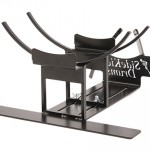 The stand is made of steel that is powder coated black. The two circular cradles for the snare have a firm foam rubber bumper glued to isolate the snare from the metal. The rear cradle is fixed in position while the front cradle is adjustable back and forth to accommodate different depth snare drums, up to 10”. The cradles will accommodate 14” and 13” diameter drums. Even though the drum just “sits” on the cradle while flanges in front and back hold the drum in place, the snare drum is pretty secure without excessive tight clamping. There is a 16” piece of thin flat metal in the rear that serves two purposes; it acts as the “hoop” for the pedal to attach to and acts as a “stabilizer” to keep the drum and stand from tipping over on the site. The spurs in front are adjustable and are attached to a nice front piece that has the company name laser cut into it. This is a well designed piece of gear, made of sturdy but light metal.
The stand is made of steel that is powder coated black. The two circular cradles for the snare have a firm foam rubber bumper glued to isolate the snare from the metal. The rear cradle is fixed in position while the front cradle is adjustable back and forth to accommodate different depth snare drums, up to 10”. The cradles will accommodate 14” and 13” diameter drums. Even though the drum just “sits” on the cradle while flanges in front and back hold the drum in place, the snare drum is pretty secure without excessive tight clamping. There is a 16” piece of thin flat metal in the rear that serves two purposes; it acts as the “hoop” for the pedal to attach to and acts as a “stabilizer” to keep the drum and stand from tipping over on the site. The spurs in front are adjustable and are attached to a nice front piece that has the company name laser cut into it. This is a well designed piece of gear, made of sturdy but light metal.
I tried it with several different size snare drums. It was very stable and it produced the desired effect despite my weak left foot... :-)
The Snare Kick Riser Stand is available from the manufacturer for $109.99 at www.sidekickdrums.com. They also make specialty snare drums and bass drums. Dealers are welcome too.
DrumClip - External Ring Control
This is a nice simple little tone control device that solves a lot of problems. Head treatments over the years, for the most part, have been everything from home made duct tape concoctions to rocket science Rube Goldberg type mechanisms to plastic rings. This product, to me, is the most logical device yet. No moving parts, sleek design, low profile and low maintenance. The idea for DrumClip may have come from the plastic clips on clip–on drum microphones. It can be called a muffler, but overtone controller is a better description.
DrumClip is made of a flexible plastic that snaps securely onto the hoop of a drum. It won’t come off unless you take it off and it stays in place. The broad surface that interacts with the drum head is strategically aligned to put only slight pressure on the head, which is enough to cancel the vibrations in the outer two inches of the head where most of the ringing happens. It comes with two different optional stick on pads; one felt and one rubber pad, that can be applied to the unit to further dampen the head.
What I like about the way DrumClip works is that it isn't attached to the head like plastic do-nut rings, duct tape, wallets, etc.
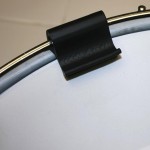 It stays in place and the head vibrates against it (or doesn't vibrate against it depending on how you want to look at it). DrumClip is small enough that it can stay on the drum when in transport in a case or bag, or thrown into a stick bag or cymbal bag. It can be detached on the fly for those times when you don’t want ring control. There are two models; the Regular DrumClip for toms and snares 12” and larger, and the Small DrumClip for toms 12” and smaller as well as larger toms. Both models can be used on bottom heads as well.
It stays in place and the head vibrates against it (or doesn't vibrate against it depending on how you want to look at it). DrumClip is small enough that it can stay on the drum when in transport in a case or bag, or thrown into a stick bag or cymbal bag. It can be detached on the fly for those times when you don’t want ring control. There are two models; the Regular DrumClip for toms and snares 12” and larger, and the Small DrumClip for toms 12” and smaller as well as larger toms. Both models can be used on bottom heads as well.
I played on drums outfitted with a variety of DrumClips at PASIC last month and they work great. I’ve been experimenting with the Regular DrumClip on my snare drums and really like the variation in controlling overtones that I can get with the different pads.
DrumClips can be ordered from the manufacturer’s website www.thedrumclip.com for $6.95 apiece plus sales tax and shipping.
Ancient Tree - "The Architect Model"
Following in the footsteps of so many American drum makers, Ed Mendel honed his master woodworking skills in fields somewhat far remote from drum making. Located in Gainesville, FL, Ed has worked under a master craftsman in cabinet making and is a custom home builder and designer, as well as a General Contractor. Being a life-long drummer, Ed sought out something different in drums. Through experimentation and trial and error, Ed founded a company with a slightly different focus: Ancient Tree Drums.
I first came across Ancient Tree Drums when I was at the Chicago Drum Show a few years ago. They immediately stood out to me from the rest of the crowd. They not only looked like percussive art, but they sounded like percussive art!
The whole presentation exuded a sort of historic…..older-than-dirt….artsy…..and just down-right cool kind of vibe. I ended up coming back a couple of more times, tapping and examining the different models presented before pulling the trigger on a model Ed refers to as “The Architect:” a vertical stave constructed, river recovered, cypress heartwood drum with rock maple hoops and very artsy, dark/rust powder-coated lugs. I just loved the sound I was hearing: It sounded like the snare drum I’ve been hearing in my head for years, and it didn’t look like any other drum around. It immediately became one of my “go-to” drums.
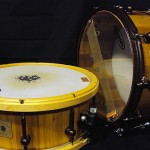 Since then, I’ve had Ed make me a similar drum, another Architect model, with 2.3mm, triple-flanged matching metal counter hoops. The drums are almost identical in construction and design, but, have some very different sonic qualities due to the difference in counter hoops and being from different river recovered logs. (Each Ancient Tree drum has its own unique characteristics.)
Since then, I’ve had Ed make me a similar drum, another Architect model, with 2.3mm, triple-flanged matching metal counter hoops. The drums are almost identical in construction and design, but, have some very different sonic qualities due to the difference in counter hoops and being from different river recovered logs. (Each Ancient Tree drum has its own unique characteristics.)
Both shells are a 6” x 14”, 20 piece stave construction with vertically running grain, which helps to bring out the lower fundamental tones of the shell, and are about ½” thick.
These particular shells have a very solid, low-end punch that I don’t very often hear in a snare of this size. Along with extreme sensitivity and crispness, there’s a lot of power here.
The cypress heartwood has an estimated age of around 1500 years and has spent roughly 150 years at the bottom of a river in Florida. Being a heartwood, it contains a large enough percentage of resign to prevent it from absorbing water, preserving it on the river bed in a relatively “dry” state. The grain of this wood is so tight (as well are the joints holding the staves together) and clear, it rivals maple. This river recovered cypress heartwood is undoubtedly one of the rarest woods around.
Both drums are equipped with Evans heads; PureSound twenty-strand snare wires, Trick three-step snare throw-off, and powder-coated, custom-milled, aeronautical aluminum single post lugs. The lugs and the 2.3 triple-flanged metal counter hoops have a nice dark, three dimensional look and feel that adds to the overall warmth of this small piece of art.
In playing Ancient Tree drums for the last few years, I’ve come to know them pretty well. The shell has the projection of maple, but with a serious warmth and “Earthy-ness” that can only come from this type of wood.
From a response and sensitivity standpoint, I think this may be one of the most sensitive drums I’ve played in years. Every note is clear and articulate at any volume. The main difference I find between the two models centers on the counter hoops. As one might expect, the metal hoops bring out a brighter timbre and overall crack with a certain openness that gives this drum a bit more volume and life than the wooden hoops allow. The wooden hoops seem to give a more controlled sound.
 The difference in the logs that make up the shells also weighs in on the over-all timbre. The model with the metal hoops utilizes some lighter colored wood, which I suppose adds to a slightly brighter sound quality as opposed to the mostly darker colored wood which makes up the rock maple counter hoop drum. Granted, these are all small nuances that make up the characteristics of any drum, but definitely ones you want to take into consideration when picking your next best drum!
The difference in the logs that make up the shells also weighs in on the over-all timbre. The model with the metal hoops utilizes some lighter colored wood, which I suppose adds to a slightly brighter sound quality as opposed to the mostly darker colored wood which makes up the rock maple counter hoop drum. Granted, these are all small nuances that make up the characteristics of any drum, but definitely ones you want to take into consideration when picking your next best drum!
Ancient Tree Drums also come in a variety of other great woods, materials, sizes and combinations. Ed also currently offers other rare and ancient, river recovered heartwoods in Longleaf & Curly Pine varieties, in addition to Black Southern Cherry, and Black Walnut. All wood selections are subject to availability. But as Ed discovers different woods, different models will always be offered. In addition to the rock maple hoops, Ancient Tree also makes some custom hoops with wood combinations such as segmented rock maple/cherry as well as other domestic and exotic materials, along with wood in-lays for that extra touch. The hardware combinations also seem to be varied: to see what Ed and Ancient Tree Drums are currently offering, visit them at the web-site to see what’s new.
So, the sound isn’t necessarily “different”…..it’s just a great sound, which is exactly what Ed set out to do! It sounds like a great snare drum with its own distinct characteristics. If you’re looking for that one drum that combines sonic and visual superiority as well as the craftsmanship and rarity of valuable art, I would have to recommend a serious look at these Ancient Trees and this master drum builder.
From Lancaster County PA, Thoughts from the shop………. Brian Hill
Canopus Zelkova Snare Drum
Before I get into the meat of this review, let me say that I was already very familiar with the Zelkova snare drums, having played a few over the years. I knew what to expect with this particular review drum. I have a predisposed bias to this drum so I apologize in advance for gushing.
The Shell
The Zelkova is a unique snare drum cut from a hollowed section of a 200 year old Japanese Zelkova tree stump. This wood is also called Japanese elm or redwood. Using the traditional techniques of making the barrel shaped Japanese Taiko drums, Canopus achieves the resonant and sonorous sound of the Taiko. The barrel shape is designed to be stronger than other barrel shaped stave drums which have traditionally prone to cracking. Its unique thickness and structure of the shell disperses the tension forces equally. The shell is thicker in the middle and thinner at the edges. The bearing edge is extremely sharp. The shell is seasoned for three years and the drum is dried in a specially designed wood drier to reduce the moisture content down to nine percent. This drying procedure also contributes to minimize the shrinkage and cracking of the drum shell. The snare beds are fairly shallow. The craftsmanship that goes into the shell is immediately obvious.
The Sound
Fat, warm, solid, thick, sweet, rich, sharp, strong, throaty, resonant, with a lot of body. It is a unique sound that I have never heard from another snare drum of any kind. It does not sound like maple. It has its own distinctive tonal qualities which can not really be compared to other woods. powerful love spell
Aesthetics
The gorgeous brown Zelkova wood is lacquered to bring out the appealing grain pattern. The eight tube lugs are brass with a round center brass stud. The hoops are chrome die casts.
The hardware is kept to a minimum: eight small and simple, yet somehow expensive looking, solid brass lugs, each of them attached to the shell with just one screw. The reason for eight lugs as opposed to ten is to lower the overall mass of the hardware and to allow larger sections of the shell vibrate freely, unimpeded by the lugs and screws. The revolving height adjustable tubular lug has a mechanism which enables height adjustments at the interval of plus or minus 2mm by turning its center pole. The die cast rims keep the drum perfectly in tune even with extended playing times. The snare mechanism is a simple P85 type that works well, and the snare wires are Canopus.
If you are worried about tuning with just eight lugs, don't be: the die cast rims keep the snare perfectly in tune, as I can attest, having played it for about half a year now. The leather washers under each tuning screw also help keep the heads in tune. Those washers are actually a Canopus product that can be bought separately, called "Bolt Tight". The air hole is simply that; a hole cut in the drum with no grommet, in keeping with Canopus's philosophy of minimal hardware and contact.
Testing
When I play this drum, it feels different than other drums. It feels like the shape of the shell produces more "give" in the head, which is very pleasing. The sound has a lot of character - lots of bottom but with crisp highs at the same time. And the bottom does not disappear with high tunings. The tuning range is very wide. The snare sensitivity is perfect - very even all the way across the head. The drum is very responsive and does not choke when played loudly. I was not hesitant about digging into it. The rim shots and rim clicks are very crisp while maintaining the warm, fat shell sound - not unlike a triple flanged hoop feel. Most drums with die cast hoops have a drastically sharper rim sound. The Zelkova rim sounds are more organic, even with the die cast hoops.
Conclusion
One of the best snare drums money can buy. A definite "10". I wish I owned one but I need another snare drum like I need a hole in my head. It is a very versatile drum that does not bring attention to itself in a recording mix. It's just……………right. Let's hope that the Canopus Drum Company has a long history with this holy grail drum. You can hear very accurate sound samples of the 5x14, 6.5x14 and the 8x14 models at the website.
Wake Up Call - WFL vs. Ludwig
OK people, we need to be a bit more imaginative. I mean, if you have the bucks and money is no object, by all means just go for the high-end stuff. But if you are like me, and the bank account is limited, then a little effort is required. Yeah, I wish I could buy every Gladstone drum that came along like I did when no one knew what they were or who he was (well, practically no one). But with the escalating prices of vintage drums, I have to be more creative. Personally, I am in rapt ecstasy over the current price trend of vintage drums. I genuinely surprised and amused when I see vintage drum collectors whine and cry (sometimes belligerently) over these price trends. DUDE, your collection is going up in value. OK, you can think the $165,000 this and the $65,000 that is absurd, but the $50 this and $100 that, you bought 10 years ago is going up too.
Be that as it may (some people love to whine), if you are on the hunt don’t limit yourself. I’ll give you a recent example from my personal experience. I am far from being a Ludwig expert but if I have heard it said once that the COB Ludwig Supraphonic is the best sounding metal snare, I’ve heard it a thousand times. That coupled with the dilemma of determining if a vintage Ludwig metal snare is indeed brass, I was surprised to see one go for the “cheap” on eBay. Click here to see the auction page.
OK so I am also not a Ludwig collector (last NSMD article notwithstanding) but for a second, I considered jumping into the fray, if anything to see what all the hoopla was all about. Then I thought “BASTA” (enough!) stay focused Chet! But, there has to be someone out there who needs this drum and it was only a three-day auction. So, little ‘ol benevolent me thought “put this up on Facebook.” I have two Facebook accounts, my personal one and one I created for Billy Gladstone. Gladstone’s site has more friends than mine (I can’t understand why) so to get the word out I posted the eBay auction with the description “I am not a Ludwig expert, but aren’t these WFL era Supraphonic snares rare? And because it is that old, doesn’t that signify that it is the desired COB shell? A bit rough but it could be brought back. Better hurry…only 2 days left…” Good friend Todd Reemy commented “in my day I sold 150 or more COB Ludwig's...of that number just 2 were WFL...I've always said they were the best sounding of the bunch with Trans badge era being 2nd...” In his day, Todd went by “The Drum Detective” moniker when he was in the retail vintage drum business. And “Dective” he was. His posts in the “For Sale” section in NSMD made my mouth water. This of course, gave my assumption validity so I passed this information along to the seller.
Hey, what goes around comes around. I have had many a helping hand in my day. I knew he would receive “Buy It Now” offers so I wanted to warn him. The seller, who seemed a bit naïve by his eBay description of the drum, was most appreciative and posted my comments in the listing.
When I sent the message one day into the auction, the listing had a paltry $172.49 current bid (up from and opening $149.99 start bid) with only 7 bids and 149 views. The numbers subsequently went up, bids to 22 and a current bid of $701.99 the final day of the auction. I, feeling like the Good Samaritan, was curious where the auction would end… 538 views, 33 bids, with a winning bid of $1009.99. At first I thought “He did well.” Then I searched eBay for other COB Ludwig snares and found this Ludwig Supraphonic COB that went for $1300.
OK, it is pretty. Yes, “Minty”…god I hate that word…when is anyone going to learn the true definition of the word “mint”? read eBay’s take on the subject. My personal definition of mint and that of coin collectors is one word “Uncirculated.” That means untouched by human hands. So if it is still sealed in the original box, it is mint. “New old stock” is exactly that, unsold, new, but not mint. Be that as it may, Todd, whom I consider an expert, said, “in my day I sold 150 or more COB Ludwig's...of that number just 2 were WFL.” That puts the odds at 75 to one, no? OK, I’m not saying the “fair condition” WFL is worth $74,449.25 more than the “Original” Ludwig but less? I don’t think so.
Yes, Mr. WFL is not cosmetically as nice as Mr. Ludwig, but therein is the answer. With a little imagination, read “elbow grease”, it is definitely 75 times the drum. Unless a drum is mint, I personally like to see patina. It gives the instrument character. It has been used, played, enjoyed. Patina does not include dirt and rust so some work is required here. Again, my personal call is less is more. I will not use a buffing wheel. If it cant be removed by hand, it is patina. The bent rim (being brass) could easily be straightened. Imagine what a little work will do for this drum.

